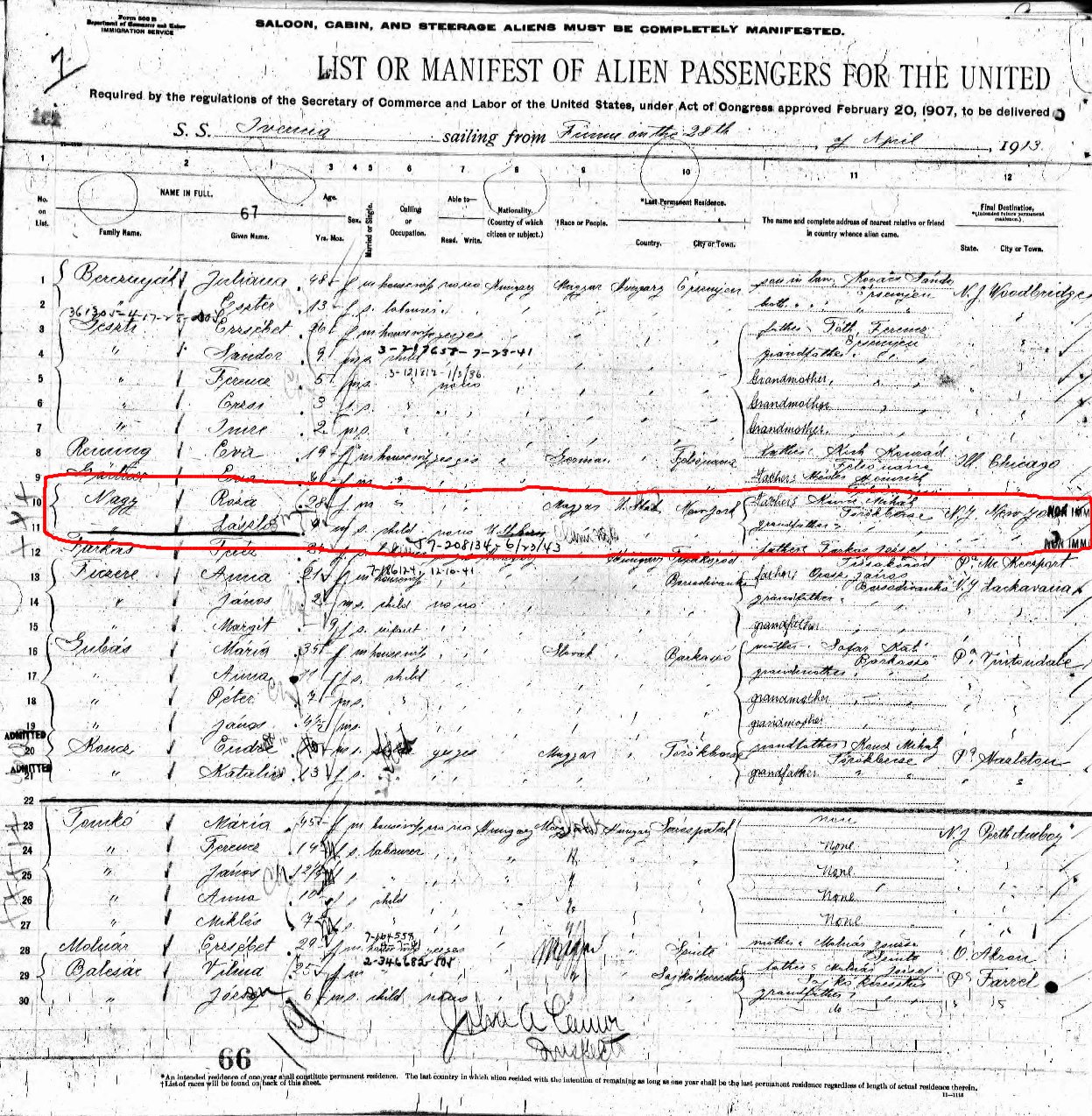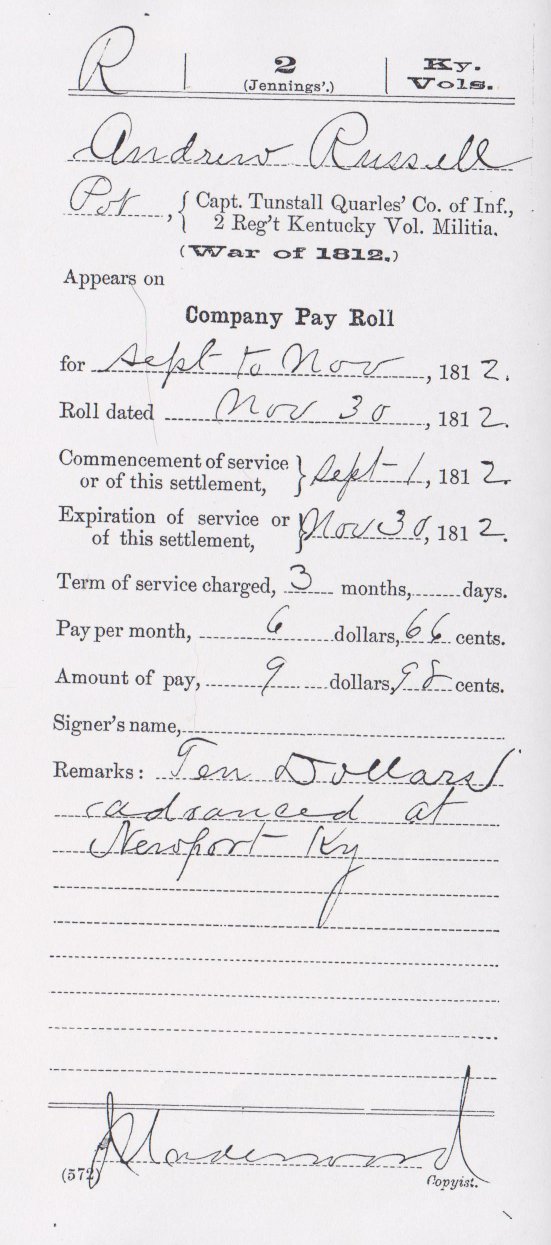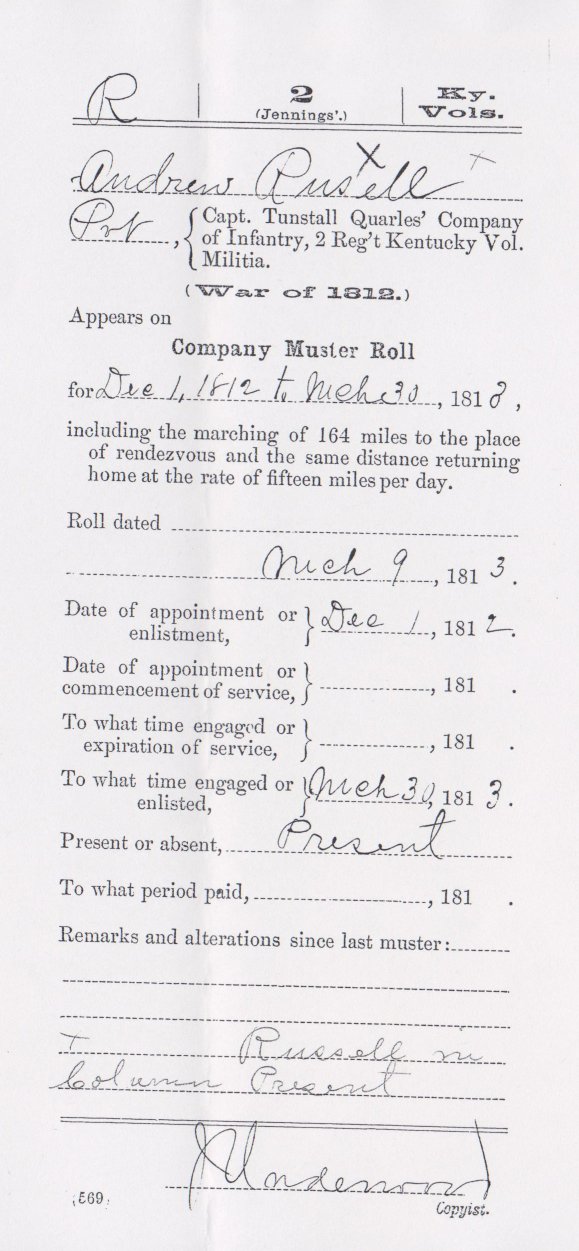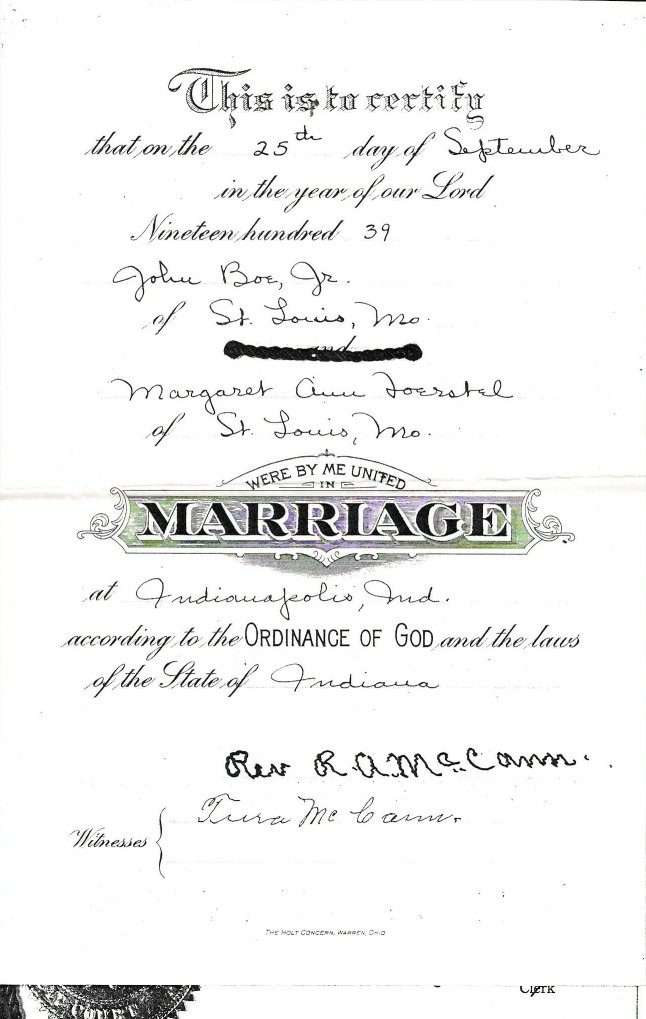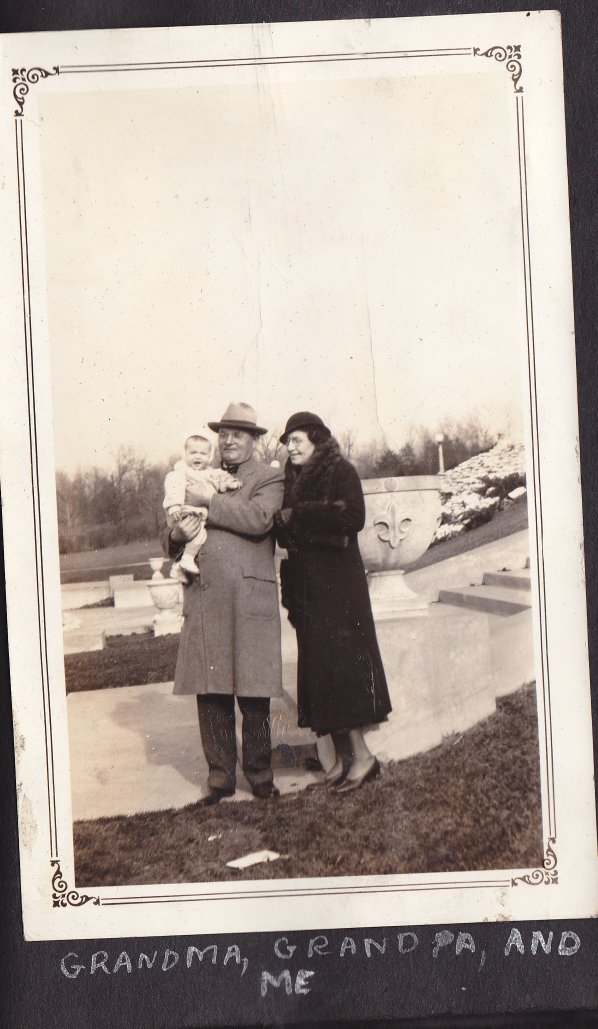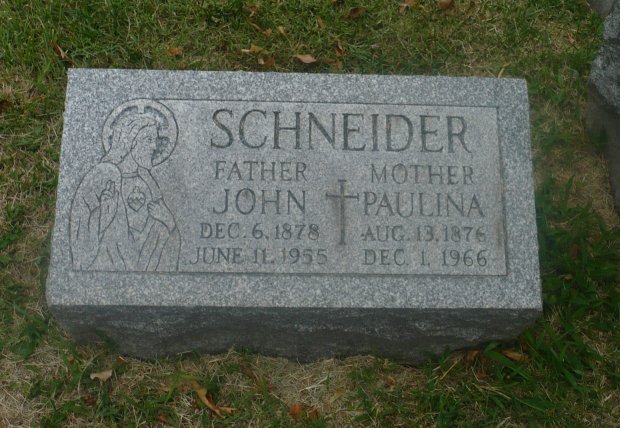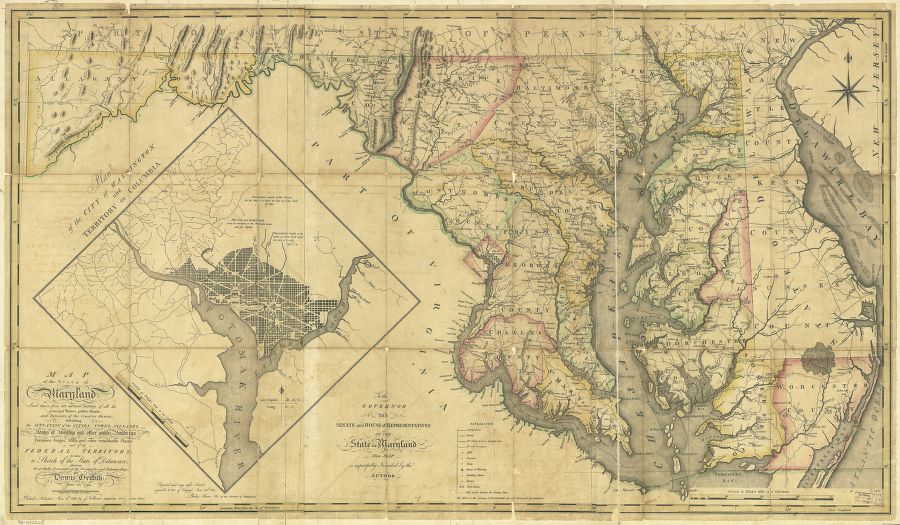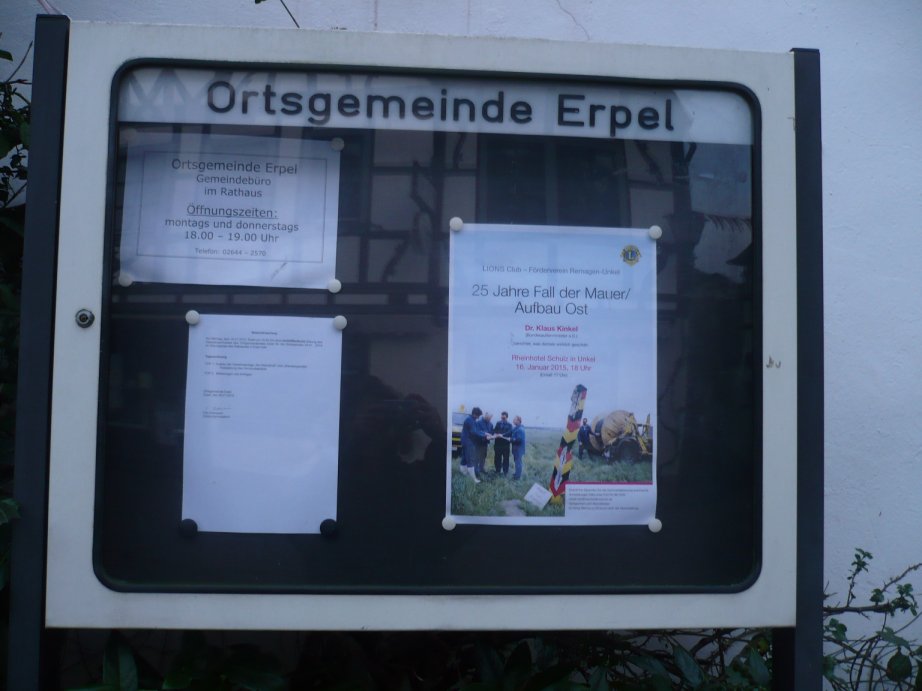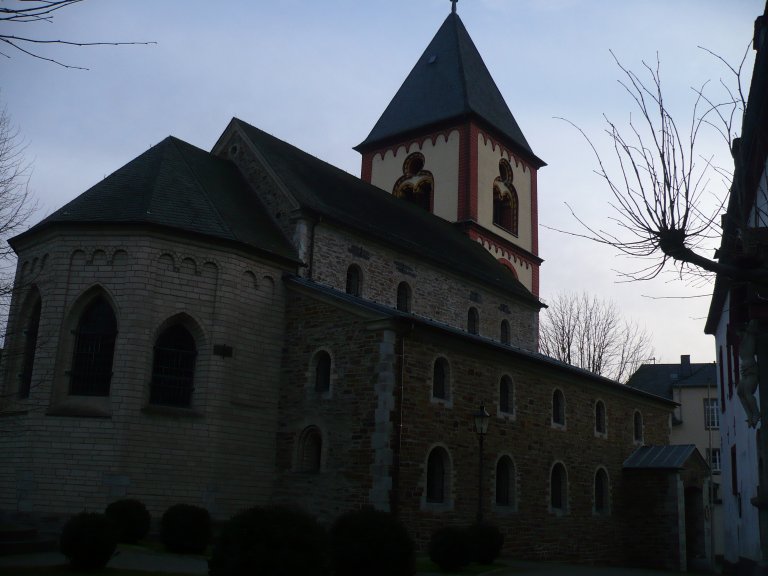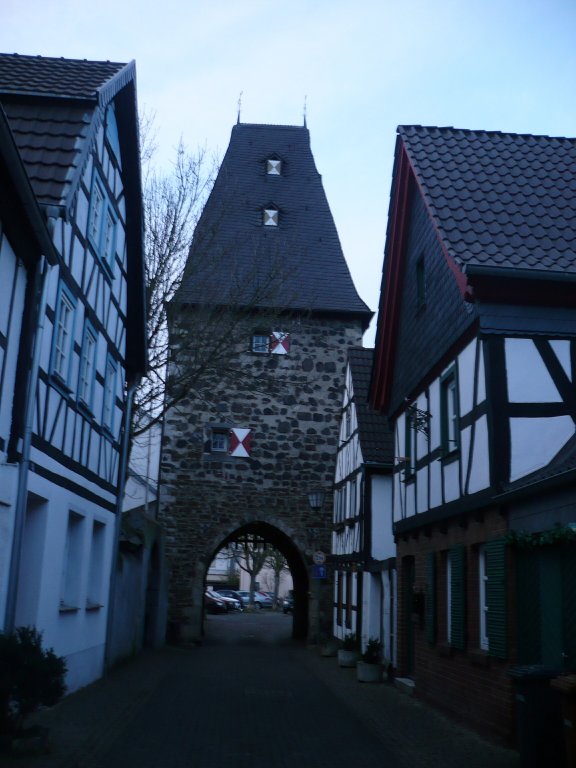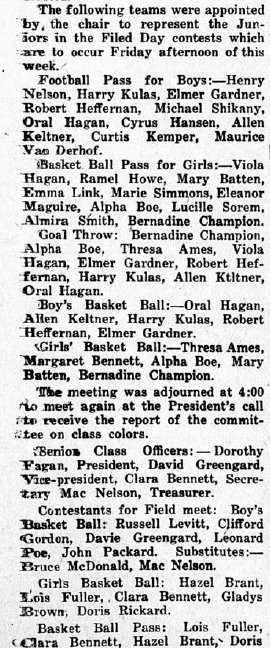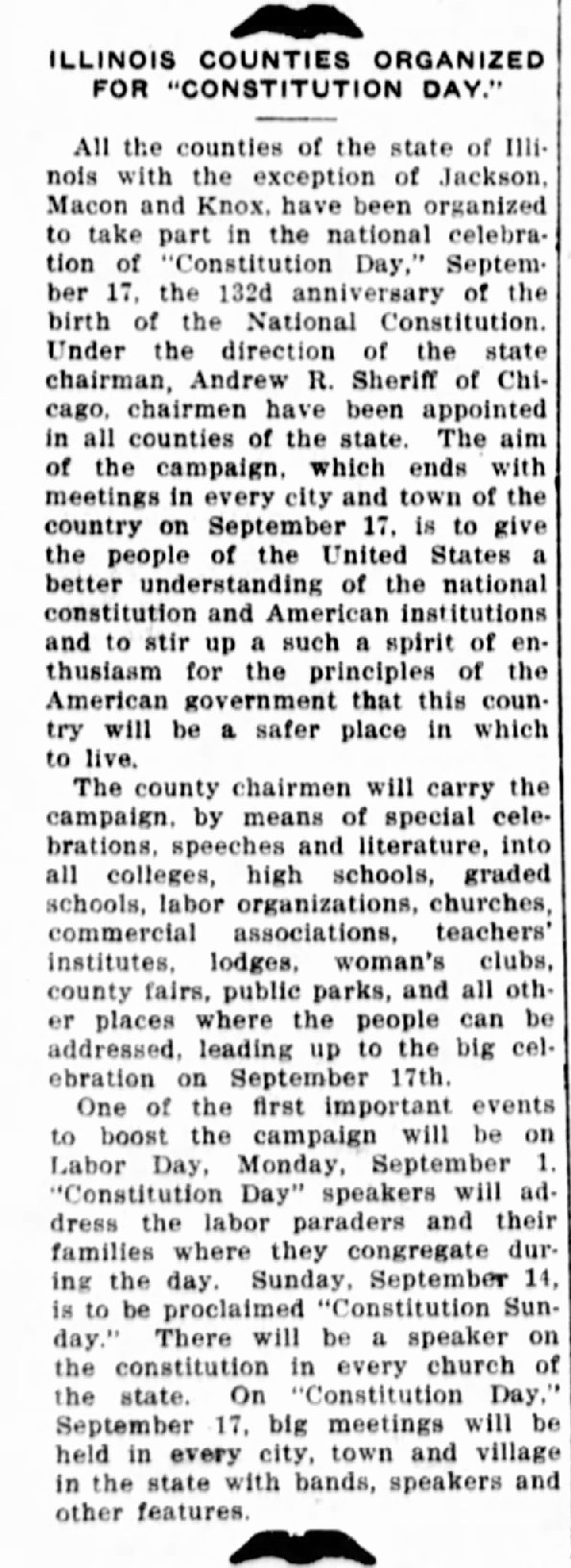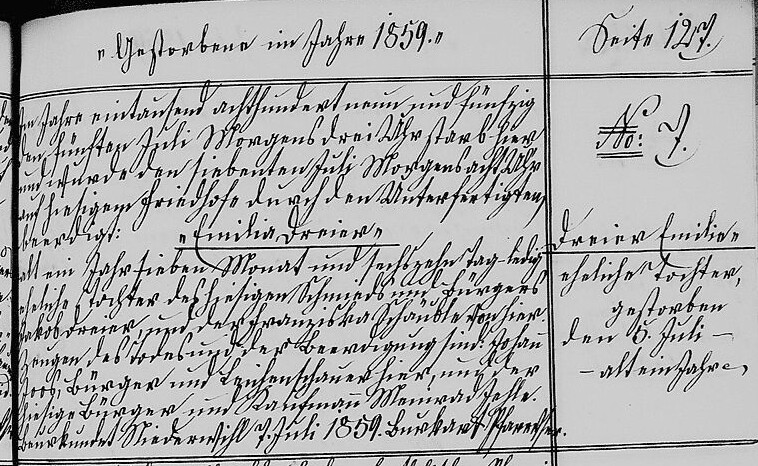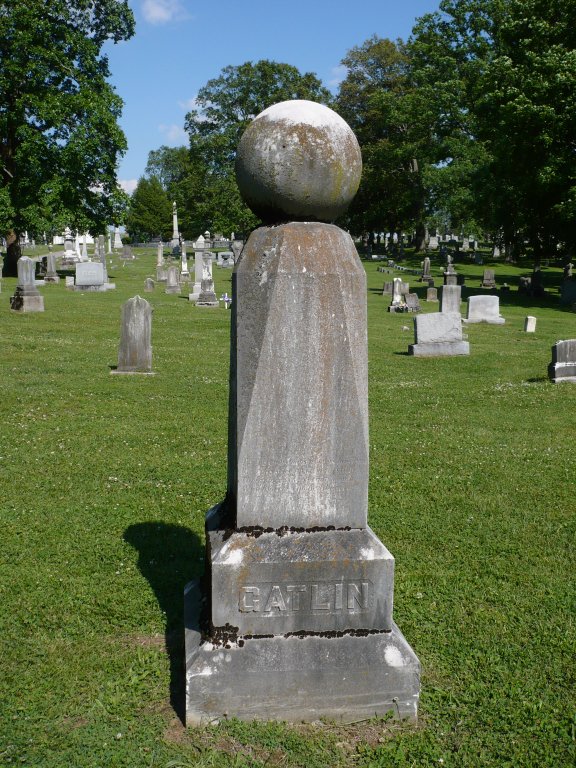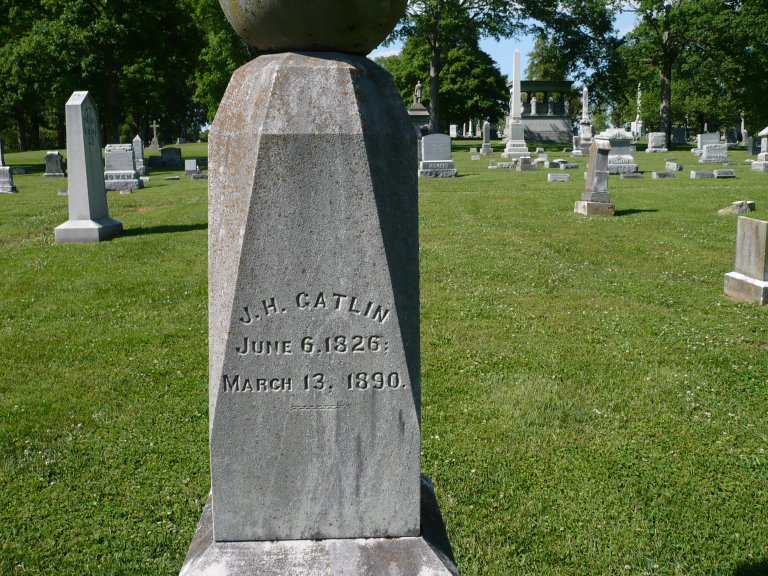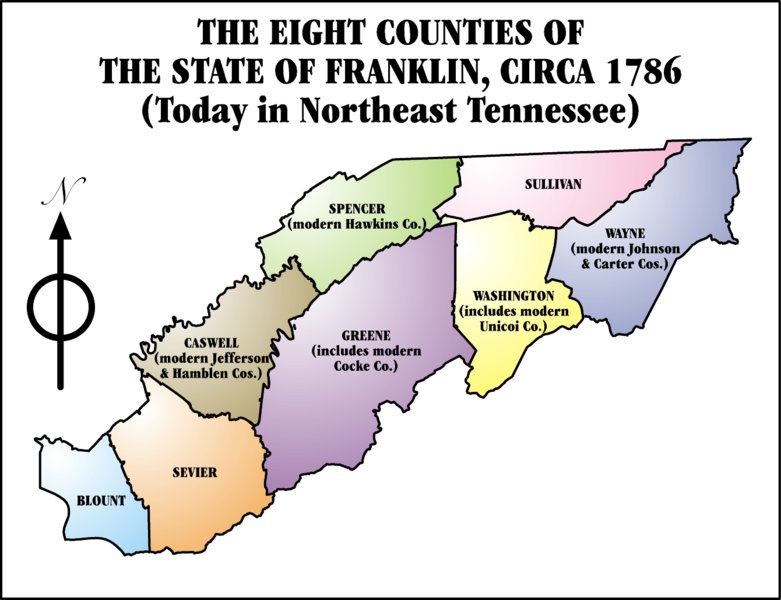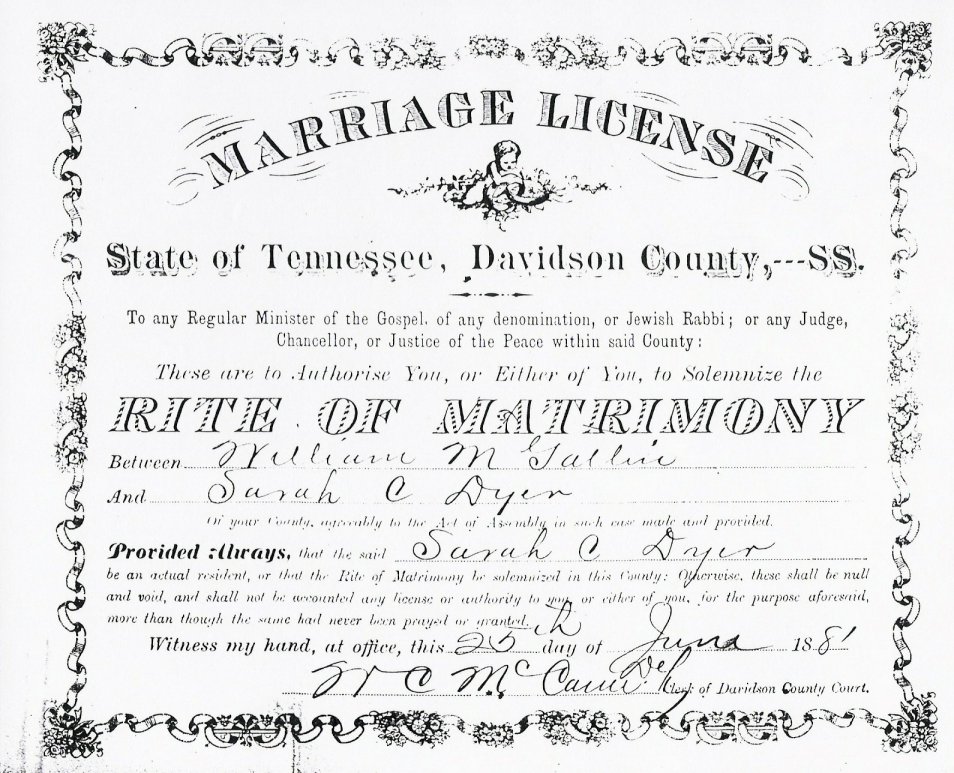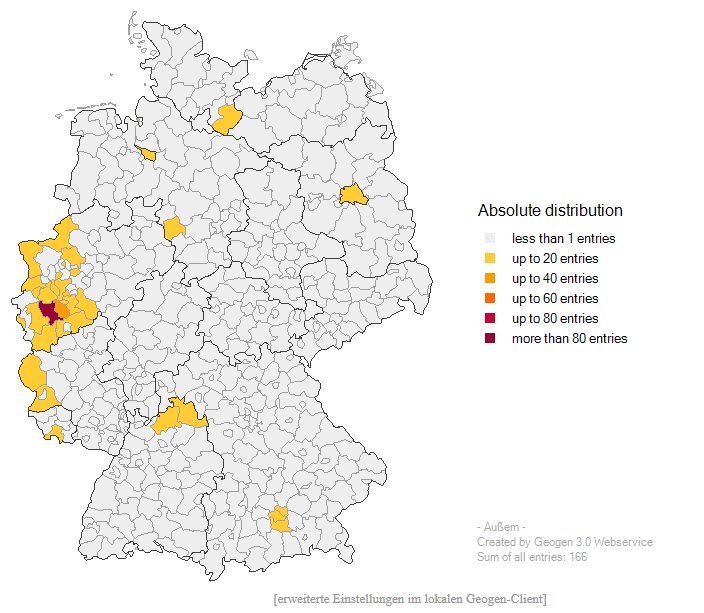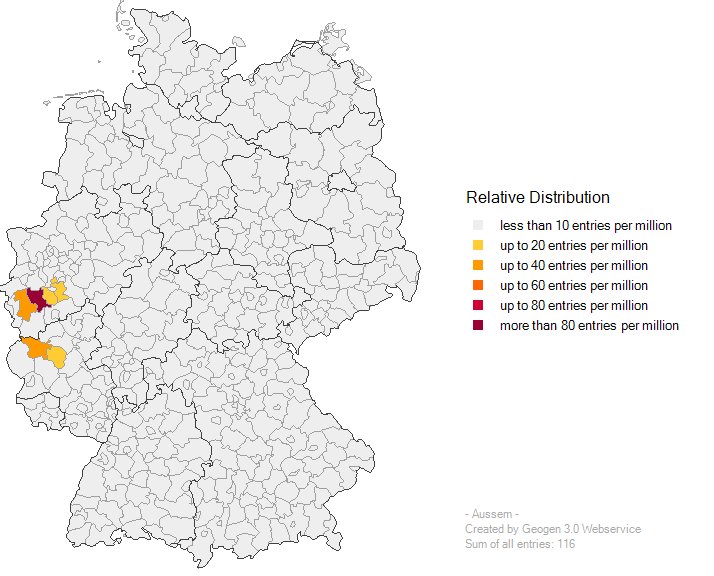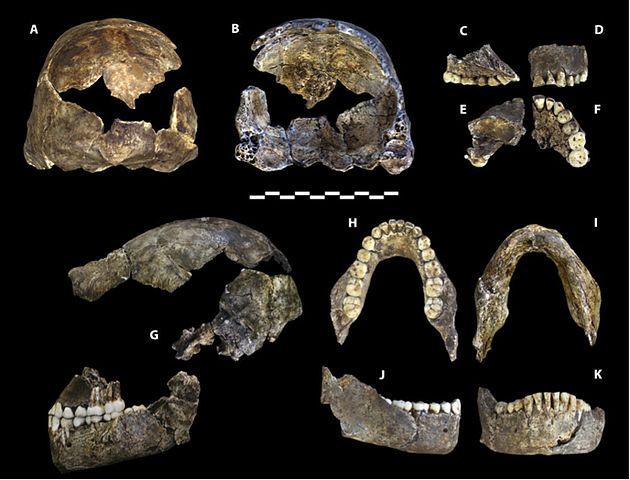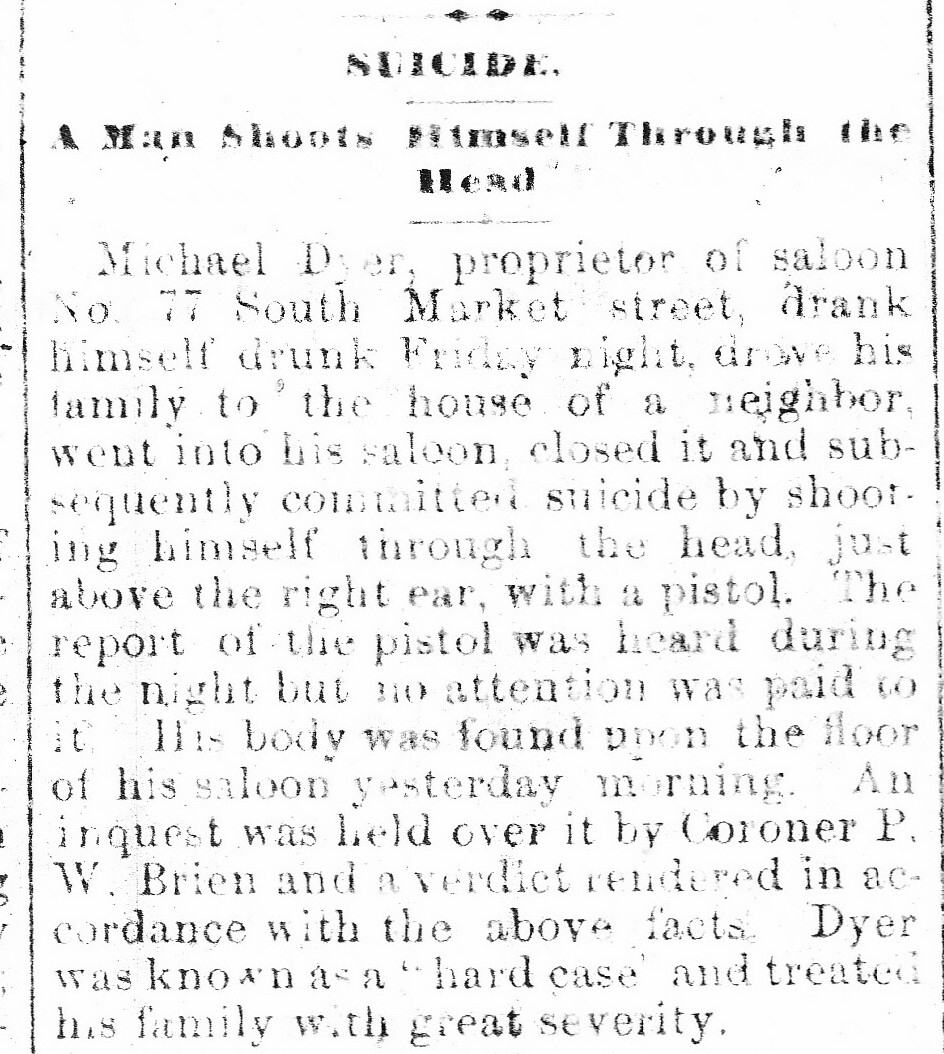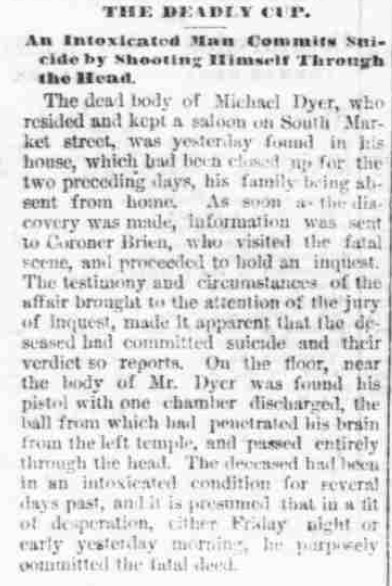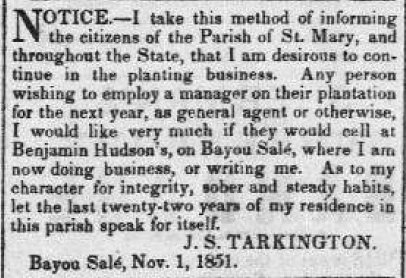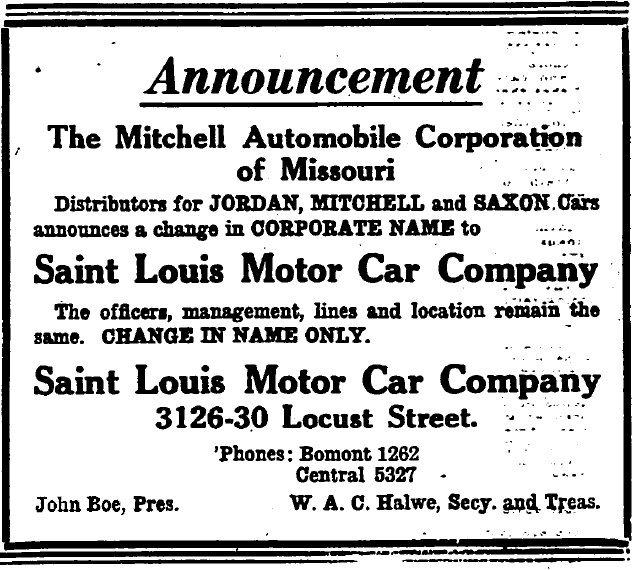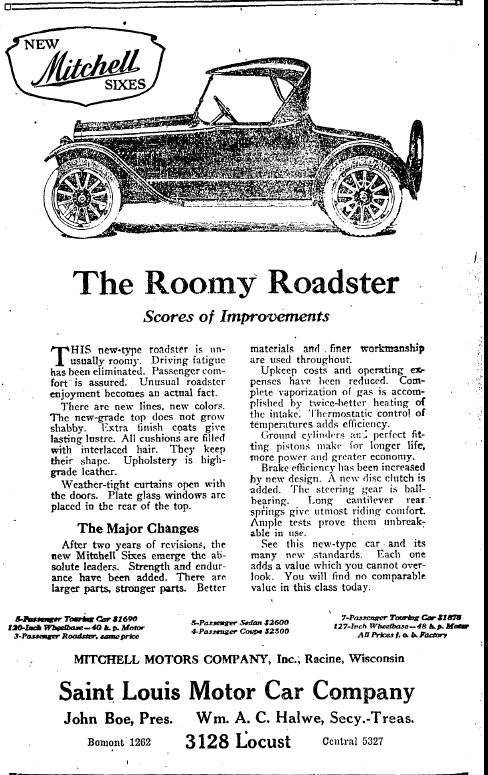Covering genealogy, family history, historical events and places, and anything else related!
Wednesday, September 30, 2015
Tuesday, September 29, 2015
Travel Tuesday: Laszlo and Rosa Nagy's Trip to the Kingdom of Hungary
When he was a young child, my maternal grandmother's sister's husband Laszlo James Nagy and his mother Rosa (Koncz) Nagy traveled to the Kingdom of Hungary to visit family. Laszlo's grandfather (and Rosa's father) was listed as the nearest relative on the passenger manifest for their trip back home to New York. He lived in Törökbecse, Torontál County, Kingdom of Hungary (now Novi Bečej, Central Banat District, Vojvodina, Serbia). They sailed home from Fiume (now Rijeka, Croatia) on the Ivernia and arrived in New York City on 17 May 1913. Laszlo was only four years old.
Ancestry.com. New York, Passenger Lists, 1820-1957 [database on-line]. Provo, UT, USA: Ancestry.com Operations, Inc., 2010.Year: 1913; Arrival, New York, New York; Microfilm Serial: T715, 1897-1957; Microfilm Roll: Roll 2080; Line: 11; Page Number: 132.
Ancestry.com. New York, Passenger Lists, 1820-1957 [database on-line]. Provo, UT, USA: Ancestry.com Operations, Inc., 2010.Year: 1913; Arrival, New York, New York; Microfilm Serial: T715, 1897-1957; Microfilm Roll: Roll 2080; Line: 11; Page Number: 132.
Monday, September 28, 2015
Military Monday: More Information on Andrew Russell, Private in 2nd Regiment Kentucky Volunteer Militia, War of 1812
My 5th-great-grandfather Andrew Russell was a private in Tunstall Quarles' Company of Infantry, 2nd Regiment Kentucky Volunteer Militia during the War of 1812. According to the book Soldiers of the War of 1812, the men in the company were enlisted from 1 September 1812 to 1 October 1812. I recently received Andrew Russell's compiled service record from the National Archives and Records Administration, and found out that he served with the company for a longer period of time. He was enlisted from 1 September 1812 to 30 March 1813.
The 2nd Regiment Kentucky Volunteer Militia Reenactment Group has a unit history on their Web site. By looking at the history and the compiled service record, I can see what Andrew was doing during the War of 1812.
The unit history states that the 2nd Regiment Kentucky Volunteer Militia was formed in Frankfort, Kentucky on 1 September 1812. The regiment marched to Lexington, Kentucky, and then went to Newport Barracks in Newport, Kentucky. The men received 2 months' advance pay at Newport.
The company pay roll dated 30 November 1812 states that Andrew Russell was advanced ten dollars at Newport.
Compiled service record, Andrew Russell, Pvt., Tunstall Quarles' Company of Infantry, 2nd Regiment Kentucky Volunteer Militia, War of 1812. Record Group 94. National Archives, Washington, DC.
By mid-September, the men had arrived at General William Henry Harrison's headquarters in St. Marys, Ohio. They then headed north and constructed Fort Jennings. It was completed in October 1812. They remained at Fort Jennings on garrison duty.
Several months later, the men headed further north, and got as far as Put-in-Bay, Ohio. They were then sent back to Cincinnati, and were discharged in 1813.
According to the company muster roll dated 9 March 1813, the company marched 164 miles to the rendezvous, and 164 miles back. They marched about fifteen miles per day.
Compiled service record, Andrew Russell, Pvt., Tunstall Quarles' Company of Infantry, 2nd Regiment Kentucky Volunteer Militia, War of 1812. Record Group 94. National Archives, Washington, DC.
The 2nd Regiment Kentucky Volunteer Militia Reenactment Group has a unit history on their Web site. By looking at the history and the compiled service record, I can see what Andrew was doing during the War of 1812.
The unit history states that the 2nd Regiment Kentucky Volunteer Militia was formed in Frankfort, Kentucky on 1 September 1812. The regiment marched to Lexington, Kentucky, and then went to Newport Barracks in Newport, Kentucky. The men received 2 months' advance pay at Newport.
The company pay roll dated 30 November 1812 states that Andrew Russell was advanced ten dollars at Newport.
Compiled service record, Andrew Russell, Pvt., Tunstall Quarles' Company of Infantry, 2nd Regiment Kentucky Volunteer Militia, War of 1812. Record Group 94. National Archives, Washington, DC.
By mid-September, the men had arrived at General William Henry Harrison's headquarters in St. Marys, Ohio. They then headed north and constructed Fort Jennings. It was completed in October 1812. They remained at Fort Jennings on garrison duty.
Several months later, the men headed further north, and got as far as Put-in-Bay, Ohio. They were then sent back to Cincinnati, and were discharged in 1813.
According to the company muster roll dated 9 March 1813, the company marched 164 miles to the rendezvous, and 164 miles back. They marched about fifteen miles per day.
Compiled service record, Andrew Russell, Pvt., Tunstall Quarles' Company of Infantry, 2nd Regiment Kentucky Volunteer Militia, War of 1812. Record Group 94. National Archives, Washington, DC.
Sunday, September 27, 2015
Ancestor Appreciation Day
September 27 is Ancestor Appreciation Day. To show appreciation for my ancestors, I have created a word cloud with family surnames.
Our ancestors helped to make us who we are today, and live on in us. Liam Callanan expressed this well in The Cloud Atlas: "We all carry, inside us, people who came before us."
Word cloud generated with WordItOut
Our ancestors helped to make us who we are today, and live on in us. Liam Callanan expressed this well in The Cloud Atlas: "We all carry, inside us, people who came before us."
Saturday, September 26, 2015
52 Ancestors: Week 39 "Unusual": Mathias Joseph Nagel
The most unusual record I have found is an article from the Congressional Record that was written by my 2nd great-grandmother Christina Nagel's brother, Mathias Joseph Nagel. Mathias was a landscape gardener and had owned a nursery in Jefferson City, Missouri. After he moved to Santa Fa, New Mexico, he shipped caña agria (also called canaigre) to Germany (his homeland). In 1914, his views on the Forestry Service were published in the Congressional Record.
There being no objection, the article was referred to the Committee on Agriculture and Forestry and ordered to be printed in the RECORD, as follows:
Our system of agriculture is the most theoretic and impractical system in existence. It is the ruin of foresters and forest. It is the ruin of farmers and farms, wasting labor and money, creating floods and destruction, misleading the Government and public with theoretic statistics. The most important branch of our Government, the Forestry Service, is managed by theoretic professors and college boys. They are not acquainted with practical work.
The report of the special forestry committee of the conservation congress is misleading to the Government and public. The theoretic addresses are most impractical, and not a word is mentioned about how to correct the ignorance of practical forestry. If this system of forestry was advised by a man in France or Germany, he would be considered incompetent. This report said on page 359, "It is estimated that seven and a half million acres of denuded forest land in the national forest require reforestation. Under the present plan 30,000 acres are reforested annually." I am sure not half of it has a stand. I can advise and teach the present force of men to reforest 500,000 acres annually at a much less expense than at the present time. The report says, "It will cost $12 per acre to reforest." I can teach and will take the contract to reforest every acre of denuded land, abandoned farms and fields in the United States for less than $5 per acre, and all will grow. By this method more than $50,000,000 can be saved in reforesting seven and a half million acres.
The report says nothing of how to prevent floods, regulate the flow of waters in the rivers; nothing of the useless and misleading publications by impractical professors and employees in agricultural colleges that are ruining the farm and forest. An investigation should be made by men who are experienced and competent in practical agriculture. I can prove what I say and can advise how to change our system of agriculture so as to better conditions.
If the Government, States, counties, townships, and farmers will work in harmony, we can reforest 2,000,000 acres each year, as can be demonstrated.
Statements about German forest and forester are false, erroneous, and misleading; such publications are to draw more money from the Public Treasury.
All abandoned farms and fields should be reforested, and dams should be built in all ravines and creeks to store the water and prevent the silt from washing into the rivers. This will regulate the rivers and floods. No estimation can be made at the present time as to how much water could be stored for the benefit of farm and forest.
If the money appropriated by the Smith-Lever bill would be spent judiciously by practical experienced men of agriculture, men who know the conditions of farms and farmers and do know how to teach farmers, that bill would be a blessing and would help to double the crop of agriculture; but, as proposed; to send inexperienced college boys to instruct farmers, it will do very little good and will work harm.
The most important and vital question at the present time is how to improve our farms and keep the rural population on the farm. The Roman Empire died of excess of urbanism. The Roman Empire, so strong and well cultured in art and literature, erred in neglecting agriculture. To satisfy the plebeian in the cities they built magnificent theaters, temples, and monuments that we admire to-day but neglected agriculture, and it was ruined. The people have pressed to the populous centers until the cities are overrun with beggars, loafers, and tramps. The newly rich families only seek to spend their money so as to show their wealth and compete with older families in luxuries, causing the poorer class to envy them and curse the situation. The cities in competing with one another advertise the schools and the pleasures they have in the cities and attract the attention of the rural population. The high cost of living is unnecessary. The present condition of the United States is very similar to the condition of the Roman Empire in the second and third centuries. Our theoretic system of agriculture will be our ruin. This impractical system is ruining farm and forest. We have to change our system of agriculture to increase the rural population, improve farms and farming, and we soon will reduce the high cost of living. Impractical education is reducing the rural population and increasing the consumers.
The rural population can keep up prosperity of the land. The farmer has to provide for all. Ruin the farm and the country is ruined. Urbanism will be our ruin. The industries of the large cities will increase luxuries and wants. The increase of production does not keep pace with the increase of population. Our theoretical professors, without practical knowledge and experience, can not remedy this lamentable situation. The impractical education in our agricultural colleges is driving the children from the farm to the cities, thereby helping to ruin farm and forest. If we would model our system of agriculture after the English, German, and Danish systems, we could double our farm products and reforest each State in the Union with less expense than we have now.
The foresters at the James Reserve planted 6 acres with 10,000 seedlings. Mr. Mahoon planted at the Zuni Reserve 1,750 seedlings on 12 acres. Messrs. Peck, Hayes, Philips, and Myers hired Indians to plant 5,000 seedlings on 2½ acres. The supervisor in Colorado says, in his report, we planted in three years 54 acres and in one of the years 27,000 pine seedlings and 3,200 Douglas fir seedlings on 15 acres. Colorado has more than 6,000,000 acres to go over.
With such reforesting it will take 10,000 years to get over the ground and will cost twenty times as much as a practical forester would spend.
The Bureau of Forestry published how much seed was sown, how many seedlings were planted, but did not publish how many seeds or seedlings grew.
The Bureau of Forestry published how many seedlings grew in the nurseries, but did not publish how much it cost to raise these tree seedlings. It can easily be demonstrated that they can be raised for one-tenth of the present cost.
The present system is responsible for reducing many poor people almost to the point of starvation by depriving them of the privilege of collecting dead wood and seeds, the collection of which is a benefit to the individual and the forest and if not collected is a determent to the forest.
This forest system was partly responsible for the forest fires.
This forest system has directly and indirectly wasted money and forest.
This forest system had impractical college boys to start nurseries, who did not know how to start nurseries on different elevations and kinds of soil. Most of this money has been wasted if not all. This forest system sent inexperienced college boys to estimate the standing timber who had no practical knowledge whatever, so that the boys had a picnic at Government expense and made no valuable report. Publications of last year stated that 530 pounds of pine seed were sown on 45 acres. So much seed, properly planted, would plant 6,000 acres. Publications say that the foresters will sow 5,500 pounds of seed on 700 acres. Properly planted, this would plant 25,000 acres. All such seeding is now feeding rats, mice, and squirrels. The present system is not teaching forestry, but is fostering a lot of useless employees who are ignorant of the business. Three thousand foresters and rangers are worse than idle, doing very little useful work, but harassing and tyrranizing farmers, miners, small sheep and cattle owners, making false reports, depriving poor citizens from collecting dry wood, cutting grass, collecting seeds, a benefit to the citizen and grave danger for fire if left in the forest. Foresters and rangers under this present system are a detriment rather than a benefit to the forest. The few acres seeded and planted are in such a condition that a real forester would be ashamed to mention it. Many men are driven to desperation to set fire to the forest. No practical work is done for future benefit. Nine-tenths of the forestry bulletins are useless. They are of no practical use to the farmer and the average citizen can not comprehend them. The publications of the forester say we have planted 20 acres with seedlings with 15 men in 20 days, and they expect half of those seedlings to grow; one practical forester can plant more than 20 acres in 20 days and all should grow. Forest Bulletin 9S says, on page 36, the foresters sow on 1 acre 700,000 seeds of the Engleman spruce and a practical forester needs only 2,000 seeds; they sow also 360,000 seeds of the lodgepole pine and 260,000 seeds of the Douglas spruce and only 2,000 seeds are needed to the acre. This is all the work of the impractical forester. At the present rate of wasting and selling available timber and no reforesting done in 10 years we will have no available timber to sell in the West.
Foresters and rangers make reports to suit themselves. No investigations of forest are made and no man is there who can make investigation and make a correct report. If a farmer or miner complains, he will never get a just hearing and no citizen can appeal, so he has to suffer. There were reported 3,138 forest fires in 1912; 2,164 were extinguished by the rangers. Like all reports of foresters and rangers it is impossible to believe that half of that number of fires started, except the rangers themselves set fire to the forest to make a good report to headquarters. If proper care was taken of the eastern and southern forestry, it would add thousands of millions of dollars to the national wealth. Every county in the United States should have a supervisor to see that all the waste and worn-out land should be reforested. The agricultural colleges in the United States should teach forestry and agriculture. Too much theory and too little practical teaching is taught.
Every farm of 160 acres has from 5 to 10 acres of land idle that should be used for reforesting. The State authorities should require that all this land should be reforested. It would add to the comfort of the farmer and his cattle and be a beneficial ornament. The present forest system is inefficient; the Agricultural department needs practical men to direct the work. A forester should live in the forest, not 50 miles to 200 miles from the base of operations. A district forester should, every morning, direct his foresters, apprentices, and rangers to do certain useful work, especially to make fire guards and reforest, and not trouble miners and farmers. The district forester should be present while planting seedlings and not leave it to inexperienced boys and laborers.
Our president said, in his address to Kansas City, September 25, 1912, Mr. Holmes of the Agriculture Department says we can raise a bushel of wheat at the expense of 3½ cents and a bushel of corn at 10½ cents. The December crop report says it cost at the average 66 cents to raise a bushel of wheat; and in Iowa 31 cents; in Maine 72 cents to raise a bushel of corn; both are agricultural reports. The president said that in England and Germany they raise twice as much grain to the acre on land cultivated for 100 years as we do on new land. If we would model our agricultural system after the English, German, and Danish agricultural systems, we would soon raise twice as much to the acre. We have to combine the best methods of the three countries in our agricultural system to improve our farm and farmers. The publications say to use commercial fertilizers is a detriment to most farmers, without knowing how to use it for the different kinds of crops. The different kinds of soils and crops need different fertilizers, and if the soil is not enriched with stable or green manure the soil is impoverished with commercial fertilizers. Our theoretic college professors can not teach the plain farmers practical farming he himself does not know. Only an intelligent farmer can teach the plain farmers, and each county should have a few farmers taught how to analyze the soil and how to use different fertilizers on different crops—farmers learn from the farmers. Our president said we have spent $100,000,000 on commercial fertilizer. More than half was wasted by ignorance, not knowing how to use it. I learn a league is formed to ask $500,000 of Congress to experiment improving and fertilizing the soil. It can be demonstrated in two hours how to improve and fertilize the soil most practically. The speakers in our conservation congress are lamenting the impoverishing of the soil of the farms. That we raise every year less grain is a calamity for the Nation, but nobody gives any practical remedy. A practical agricultural system would remedy it. The forest association is lamenting the depleting of the forest. Theoretic addresses never give a remedy; only a practical forest system will be a remedy.
The agricultural college can not teach practical farming on 10 or 100 acres in one part of the State; neither forestry on 100 or 1,000 acres. It takes a forest to teach practical forestry by a practical forester. If the money uselessly spent at agricultural colleges and experiment stations was used to help assist poor families in the cities to start on a farm, great benefit and improvements would be the result, as many a farmer boy and girl, by the wrong, theoretic education, has left the farm for the city and to-day thousands would go to the farm if they had the means to start again. This top-heavy education of the college is a detriment and ruin to our children.
M. J. NAGEL.
Congressional Record 51 (July 2, 1914): 11517. Available from Internet Archive.
Congressional Record 51 (July 2, 1914): 11518. Available from Internet Archive.
THE FORESTRY SERVICE
Mr. CATRON. I have an article written here by Mr. M. J. Nagel on the Forestry Service, which contains about two closely written pages. It pertains to a matter which, I think, would be of interest to the committee investigating the subject, and I ask that it may be printed in the RECORD and referred to the Committee on Agriculture and Forestry.There being no objection, the article was referred to the Committee on Agriculture and Forestry and ordered to be printed in the RECORD, as follows:
Our system of agriculture is the most theoretic and impractical system in existence. It is the ruin of foresters and forest. It is the ruin of farmers and farms, wasting labor and money, creating floods and destruction, misleading the Government and public with theoretic statistics. The most important branch of our Government, the Forestry Service, is managed by theoretic professors and college boys. They are not acquainted with practical work.
The report of the special forestry committee of the conservation congress is misleading to the Government and public. The theoretic addresses are most impractical, and not a word is mentioned about how to correct the ignorance of practical forestry. If this system of forestry was advised by a man in France or Germany, he would be considered incompetent. This report said on page 359, "It is estimated that seven and a half million acres of denuded forest land in the national forest require reforestation. Under the present plan 30,000 acres are reforested annually." I am sure not half of it has a stand. I can advise and teach the present force of men to reforest 500,000 acres annually at a much less expense than at the present time. The report says, "It will cost $12 per acre to reforest." I can teach and will take the contract to reforest every acre of denuded land, abandoned farms and fields in the United States for less than $5 per acre, and all will grow. By this method more than $50,000,000 can be saved in reforesting seven and a half million acres.
The report says nothing of how to prevent floods, regulate the flow of waters in the rivers; nothing of the useless and misleading publications by impractical professors and employees in agricultural colleges that are ruining the farm and forest. An investigation should be made by men who are experienced and competent in practical agriculture. I can prove what I say and can advise how to change our system of agriculture so as to better conditions.
If the Government, States, counties, townships, and farmers will work in harmony, we can reforest 2,000,000 acres each year, as can be demonstrated.
Statements about German forest and forester are false, erroneous, and misleading; such publications are to draw more money from the Public Treasury.
All abandoned farms and fields should be reforested, and dams should be built in all ravines and creeks to store the water and prevent the silt from washing into the rivers. This will regulate the rivers and floods. No estimation can be made at the present time as to how much water could be stored for the benefit of farm and forest.
If the money appropriated by the Smith-Lever bill would be spent judiciously by practical experienced men of agriculture, men who know the conditions of farms and farmers and do know how to teach farmers, that bill would be a blessing and would help to double the crop of agriculture; but, as proposed; to send inexperienced college boys to instruct farmers, it will do very little good and will work harm.
The most important and vital question at the present time is how to improve our farms and keep the rural population on the farm. The Roman Empire died of excess of urbanism. The Roman Empire, so strong and well cultured in art and literature, erred in neglecting agriculture. To satisfy the plebeian in the cities they built magnificent theaters, temples, and monuments that we admire to-day but neglected agriculture, and it was ruined. The people have pressed to the populous centers until the cities are overrun with beggars, loafers, and tramps. The newly rich families only seek to spend their money so as to show their wealth and compete with older families in luxuries, causing the poorer class to envy them and curse the situation. The cities in competing with one another advertise the schools and the pleasures they have in the cities and attract the attention of the rural population. The high cost of living is unnecessary. The present condition of the United States is very similar to the condition of the Roman Empire in the second and third centuries. Our theoretic system of agriculture will be our ruin. This impractical system is ruining farm and forest. We have to change our system of agriculture to increase the rural population, improve farms and farming, and we soon will reduce the high cost of living. Impractical education is reducing the rural population and increasing the consumers.
The rural population can keep up prosperity of the land. The farmer has to provide for all. Ruin the farm and the country is ruined. Urbanism will be our ruin. The industries of the large cities will increase luxuries and wants. The increase of production does not keep pace with the increase of population. Our theoretical professors, without practical knowledge and experience, can not remedy this lamentable situation. The impractical education in our agricultural colleges is driving the children from the farm to the cities, thereby helping to ruin farm and forest. If we would model our system of agriculture after the English, German, and Danish systems, we could double our farm products and reforest each State in the Union with less expense than we have now.
The foresters at the James Reserve planted 6 acres with 10,000 seedlings. Mr. Mahoon planted at the Zuni Reserve 1,750 seedlings on 12 acres. Messrs. Peck, Hayes, Philips, and Myers hired Indians to plant 5,000 seedlings on 2½ acres. The supervisor in Colorado says, in his report, we planted in three years 54 acres and in one of the years 27,000 pine seedlings and 3,200 Douglas fir seedlings on 15 acres. Colorado has more than 6,000,000 acres to go over.
With such reforesting it will take 10,000 years to get over the ground and will cost twenty times as much as a practical forester would spend.
The Bureau of Forestry published how much seed was sown, how many seedlings were planted, but did not publish how many seeds or seedlings grew.
The Bureau of Forestry published how many seedlings grew in the nurseries, but did not publish how much it cost to raise these tree seedlings. It can easily be demonstrated that they can be raised for one-tenth of the present cost.
The present system is responsible for reducing many poor people almost to the point of starvation by depriving them of the privilege of collecting dead wood and seeds, the collection of which is a benefit to the individual and the forest and if not collected is a determent to the forest.
This forest system was partly responsible for the forest fires.
This forest system has directly and indirectly wasted money and forest.
This forest system had impractical college boys to start nurseries, who did not know how to start nurseries on different elevations and kinds of soil. Most of this money has been wasted if not all. This forest system sent inexperienced college boys to estimate the standing timber who had no practical knowledge whatever, so that the boys had a picnic at Government expense and made no valuable report. Publications of last year stated that 530 pounds of pine seed were sown on 45 acres. So much seed, properly planted, would plant 6,000 acres. Publications say that the foresters will sow 5,500 pounds of seed on 700 acres. Properly planted, this would plant 25,000 acres. All such seeding is now feeding rats, mice, and squirrels. The present system is not teaching forestry, but is fostering a lot of useless employees who are ignorant of the business. Three thousand foresters and rangers are worse than idle, doing very little useful work, but harassing and tyrranizing farmers, miners, small sheep and cattle owners, making false reports, depriving poor citizens from collecting dry wood, cutting grass, collecting seeds, a benefit to the citizen and grave danger for fire if left in the forest. Foresters and rangers under this present system are a detriment rather than a benefit to the forest. The few acres seeded and planted are in such a condition that a real forester would be ashamed to mention it. Many men are driven to desperation to set fire to the forest. No practical work is done for future benefit. Nine-tenths of the forestry bulletins are useless. They are of no practical use to the farmer and the average citizen can not comprehend them. The publications of the forester say we have planted 20 acres with seedlings with 15 men in 20 days, and they expect half of those seedlings to grow; one practical forester can plant more than 20 acres in 20 days and all should grow. Forest Bulletin 9S says, on page 36, the foresters sow on 1 acre 700,000 seeds of the Engleman spruce and a practical forester needs only 2,000 seeds; they sow also 360,000 seeds of the lodgepole pine and 260,000 seeds of the Douglas spruce and only 2,000 seeds are needed to the acre. This is all the work of the impractical forester. At the present rate of wasting and selling available timber and no reforesting done in 10 years we will have no available timber to sell in the West.
Foresters and rangers make reports to suit themselves. No investigations of forest are made and no man is there who can make investigation and make a correct report. If a farmer or miner complains, he will never get a just hearing and no citizen can appeal, so he has to suffer. There were reported 3,138 forest fires in 1912; 2,164 were extinguished by the rangers. Like all reports of foresters and rangers it is impossible to believe that half of that number of fires started, except the rangers themselves set fire to the forest to make a good report to headquarters. If proper care was taken of the eastern and southern forestry, it would add thousands of millions of dollars to the national wealth. Every county in the United States should have a supervisor to see that all the waste and worn-out land should be reforested. The agricultural colleges in the United States should teach forestry and agriculture. Too much theory and too little practical teaching is taught.
Every farm of 160 acres has from 5 to 10 acres of land idle that should be used for reforesting. The State authorities should require that all this land should be reforested. It would add to the comfort of the farmer and his cattle and be a beneficial ornament. The present forest system is inefficient; the Agricultural department needs practical men to direct the work. A forester should live in the forest, not 50 miles to 200 miles from the base of operations. A district forester should, every morning, direct his foresters, apprentices, and rangers to do certain useful work, especially to make fire guards and reforest, and not trouble miners and farmers. The district forester should be present while planting seedlings and not leave it to inexperienced boys and laborers.
Our president said, in his address to Kansas City, September 25, 1912, Mr. Holmes of the Agriculture Department says we can raise a bushel of wheat at the expense of 3½ cents and a bushel of corn at 10½ cents. The December crop report says it cost at the average 66 cents to raise a bushel of wheat; and in Iowa 31 cents; in Maine 72 cents to raise a bushel of corn; both are agricultural reports. The president said that in England and Germany they raise twice as much grain to the acre on land cultivated for 100 years as we do on new land. If we would model our agricultural system after the English, German, and Danish agricultural systems, we would soon raise twice as much to the acre. We have to combine the best methods of the three countries in our agricultural system to improve our farm and farmers. The publications say to use commercial fertilizers is a detriment to most farmers, without knowing how to use it for the different kinds of crops. The different kinds of soils and crops need different fertilizers, and if the soil is not enriched with stable or green manure the soil is impoverished with commercial fertilizers. Our theoretic college professors can not teach the plain farmers practical farming he himself does not know. Only an intelligent farmer can teach the plain farmers, and each county should have a few farmers taught how to analyze the soil and how to use different fertilizers on different crops—farmers learn from the farmers. Our president said we have spent $100,000,000 on commercial fertilizer. More than half was wasted by ignorance, not knowing how to use it. I learn a league is formed to ask $500,000 of Congress to experiment improving and fertilizing the soil. It can be demonstrated in two hours how to improve and fertilize the soil most practically. The speakers in our conservation congress are lamenting the impoverishing of the soil of the farms. That we raise every year less grain is a calamity for the Nation, but nobody gives any practical remedy. A practical agricultural system would remedy it. The forest association is lamenting the depleting of the forest. Theoretic addresses never give a remedy; only a practical forest system will be a remedy.
The agricultural college can not teach practical farming on 10 or 100 acres in one part of the State; neither forestry on 100 or 1,000 acres. It takes a forest to teach practical forestry by a practical forester. If the money uselessly spent at agricultural colleges and experiment stations was used to help assist poor families in the cities to start on a farm, great benefit and improvements would be the result, as many a farmer boy and girl, by the wrong, theoretic education, has left the farm for the city and to-day thousands would go to the farm if they had the means to start again. This top-heavy education of the college is a detriment and ruin to our children.
M. J. NAGEL.
Friday, September 25, 2015
Grandma and Grandpa Boe's Anniversary
Today is the wedding anniversary of my maternal grandparents John Boe and Margaret Ann Schneider. They married in Indianapolis, Indiana on 25 September 1939. Because my grandmother was divorced from her first husband, William Herbert Foerstel, she had his surname at the time of the marriage.
Thursday, September 24, 2015
National Punctuation Day
September 24 is National Punctuation Day. It is important to use proper punctuation, or you may be misunderstood. If you were writing your family history and included the sentence in the following image, it would be important to include the comma!
Wednesday, September 23, 2015
Tuesday, September 22, 2015
Tombstone Tuesday: John and Paulina (Gersbacher) Schneider
My great-grandparents John and Paulina (Gersbacher) Schneider are buried in Sts. Peter and Paul Catholic Cemetery in St; Louis, Missouri. They are in Section 35, Lot 0160. There is also a larger stone which marks the plot as the resting place of the families of C. J. (John's father Carl Joseph) and J. Schneider.
Monday, September 21, 2015
Mappy Monday: Maryland and Delaware, 1794
Griffith, Dennis; Thackara, James; and Vallance, John. Map of the State of Maryland laid down from an actual survey of all the
principal waters, public roads, and divisions of the counties therein;
describing the situation of the cities, towns, villages, houses of
worship and other public buildings, furnaces, forges, mills, and other
remarkable places; and of the Federal Territory; as also a sketch of the
State of Delaware shewing the probable connexion of the Chesapeake and
Delaware Bays. Philadalphia: J. Vallance, 1794. Library of Congress, Geography and Map Division.
Sunday, September 20, 2015
52 Ancestors: Week 38 "Favorite Place": Anna Sibylle Lindlohr from Erpel, Germany
In January, I traveled to Germany and visited some ancestral places. I loved visiting all of them, but I found Erpel especially beautiful.
Erpel is a local community (Ortsgemeinde) which is part of the collective municipality Unkel, in Kreis (district) Neuwied, in the state of Rhineland-Palatinate (Rheinland-Pfalz). It is located on the eastern bank of the Rhine River, across from Remagen, another ancestral place of mine.
My 2nd-great-grandfather Carl Joseph Schneider was born in Erpel. His father, Johann Wilhelm Schneider, was born in Remagen, and his father's mother's family lived in Remagen for generations. But on his mother Sibylle Lindlohr's side, his roots were in Erpel.
My 3rd-great-grandmother Anna Sibylle Lindlohr was born in Erpel on 20 December 1823. She was the daughter of Gottfried Lindlohr and Agathe Weiler (or Wieler). On 21 December 1823, she was baptized at Pfarrkirche St. Severinus, the Roman Catholic Church in Erpel. Her baptismal sponsors were Peter Wilhelm Stieldorf and Anna Sibylle Lindlohr, represented by Anna Maria Lindlohr.
On 24 June 1845 in Erpel, Sibylle married Heinrich Josef Hellmann from Bad Godesberg. The witnesses to the wedding were Karl Lindlohr and Matthias Jos. Klaeser. Their first child, Maria, was born on 12 March 1846. Another daughter, Adelheid, was born on 23 April 1848, but died a year later, on 26 April 1849. Their son Christian Josef was born on 11 February 1850.
Heinrich Josef Hellman died on 10 October 1850. A little more than a year after losing her husband, Sibylle lost her daughter too; Maria died on 21 February 1852.
Sibylle married my 3rd-great-grandfather Johann Wilhelm Schneider in Erpel on 20 April 1853. The witnesses to the wedding were Peter Frizam and Johann Belinger from Remagen. Less than a month later, on 15 May 1853, their daughter Anna Maria was born. Not long afterward, Sibylle lost another child: her son Christian Josef Hellmann died on 4 July 1853.
Sibylle and Wilhelm's next child, my 2nd-great-grandfather Carl Joseph, was born on 22 January 1855. Their son Johann Wilhelm (later known as John William) was born on 24 December 1856.
Sibylle's first child with Wilhelm, Anna Maria, died on 9 June 1857. Sibylle gave birth to twins, Anton and Maria Josefa, on 24 March 1859. Both children died on 17 May 1859.
Sibylle and Wilhelm had two more children, neither of whom would survive to adulthood: Gottfried, born 25 May 1860 (and died of encephalitis on 24 April 1873) and Maria Anna, born 25 February 1862 (and died 14 January 1863).
Sibylle died in Erpel on 2 April 1862. Her cause of death was listed as Auszehrung (emaciation, consumption, tuberculosis). She was buried on 5 April 1862.
Erpel is a local community (Ortsgemeinde) which is part of the collective municipality Unkel, in Kreis (district) Neuwied, in the state of Rhineland-Palatinate (Rheinland-Pfalz). It is located on the eastern bank of the Rhine River, across from Remagen, another ancestral place of mine.
View of Erpel from Remagen
My 2nd-great-grandfather Carl Joseph Schneider was born in Erpel. His father, Johann Wilhelm Schneider, was born in Remagen, and his father's mother's family lived in Remagen for generations. But on his mother Sibylle Lindlohr's side, his roots were in Erpel.
My 3rd-great-grandmother Anna Sibylle Lindlohr was born in Erpel on 20 December 1823. She was the daughter of Gottfried Lindlohr and Agathe Weiler (or Wieler). On 21 December 1823, she was baptized at Pfarrkirche St. Severinus, the Roman Catholic Church in Erpel. Her baptismal sponsors were Peter Wilhelm Stieldorf and Anna Sibylle Lindlohr, represented by Anna Maria Lindlohr.
Pfarrkirche St. Severinus, the location of many family baptisms, marriages, and funerals
On 24 June 1845 in Erpel, Sibylle married Heinrich Josef Hellmann from Bad Godesberg. The witnesses to the wedding were Karl Lindlohr and Matthias Jos. Klaeser. Their first child, Maria, was born on 12 March 1846. Another daughter, Adelheid, was born on 23 April 1848, but died a year later, on 26 April 1849. Their son Christian Josef was born on 11 February 1850.
Heinrich Josef Hellman died on 10 October 1850. A little more than a year after losing her husband, Sibylle lost her daughter too; Maria died on 21 February 1852.
Sibylle married my 3rd-great-grandfather Johann Wilhelm Schneider in Erpel on 20 April 1853. The witnesses to the wedding were Peter Frizam and Johann Belinger from Remagen. Less than a month later, on 15 May 1853, their daughter Anna Maria was born. Not long afterward, Sibylle lost another child: her son Christian Josef Hellmann died on 4 July 1853.
Sibylle and Wilhelm's next child, my 2nd-great-grandfather Carl Joseph, was born on 22 January 1855. Their son Johann Wilhelm (later known as John William) was born on 24 December 1856.
Sibylle's first child with Wilhelm, Anna Maria, died on 9 June 1857. Sibylle gave birth to twins, Anton and Maria Josefa, on 24 March 1859. Both children died on 17 May 1859.
Sibylle and Wilhelm had two more children, neither of whom would survive to adulthood: Gottfried, born 25 May 1860 (and died of encephalitis on 24 April 1873) and Maria Anna, born 25 February 1862 (and died 14 January 1863).
Sibylle died in Erpel on 2 April 1862. Her cause of death was listed as Auszehrung (emaciation, consumption, tuberculosis). She was buried on 5 April 1862.
Rathaus (town hall), built in 1780
Neutor (New Gate), the only remaining tower of the old city wall
Saturday, September 19, 2015
Sports Center Saturday: Alpha Boe
My first cousin twice removed Alpha Boe played basketball in high school. In 1917, she was one of the students appointed to represent the Williston High School juniors in the field day contests. She was on the following teams: Basket Ball Pass for Girls, Goal Throw, and Girls' Basket Ball.
In 1919, the Williston, North Dakota newspaper Williston Graphic reported on the Williston High School girls' basketball team against the Stanley, North Dakota girls' basketball team, which was the strongest team in the region. Although the Williston team lost, they played a good game. Alpha and some of her teammates were going to travel to Stanley to play another game against the Stanley team.
Williston Graphic, 4 October 1917, page 2
In 1919, the Williston, North Dakota newspaper Williston Graphic reported on the Williston High School girls' basketball team against the Stanley, North Dakota girls' basketball team, which was the strongest team in the region. Although the Williston team lost, they played a good game. Alpha and some of her teammates were going to travel to Stanley to play another game against the Stanley team.
Williston Graphic, 20 March 1919, page 1
Friday, September 18, 2015
Friend of Friends Friday: Do Not Purchase Notice, Franklin, St. Mary's Parish, Louisiana
Planters Banner, 3 February 1853, page 3
Notice.
ALL persons are hereby notified and warned not to purchase from Henry C. Dwight, of this parish, the following described slaves, to wit: William, a negro man, aged about 34 years; Isaac, aged 32 years; Hector, aged 33 years; Washington, aged 31 years; Fanny, a negro woman, aged about 30 years; Charlotte, aged 50 years; Rachael, aged 10 years; Vat, aged 58 years; Centhia, aged 27 years; Jane, aged 24 years; Betty, aged 17 years; Phebe, aged 50 years; Harry, aged 42 years; Ida, aged 15 years; Jupiter, aged 52 years; Frank, aged 27 years; Maria, aged 27 years; Jerry, aged 23 years; David, aged 50 years; Romeo, aged 45 years; Daniel; aged 45 years; Michael, aged 17 years; David, aged 14 years; Lydia, aged 11 years; Sarah, aged 45 years; Bill, aged 38 years; Mary, aged 28 years; Sydmene, aged 43 years; Nancy, aged 18 years; Massy, aged 45 years; Lewis, aged 23 years; Richard, aged 20 years; Louisa, aged 17 years; Little Betty, aged 21 years; Molly, aged 30 years; Lawra, aged 22 years; Milly, aged 14 years; Jackson, aged 19 years; Helen, aged 10 years; Joe, aged 38 years; Jack, aged 45 years; Jim, aged 36 years; Marulite, aged 7 years; Madeline, aged 38 years; Lydia, aged 30 years; or any of their increase.The title to said slaves being now in litigation in a writ pending in the District Court of this parish, entitled James Smith vs. Henry C. Dwight, No. 4447 on the docket of said court, and the undersigned having recently been informed that the said Dwight is fraudulently attempting to sell said slaves. Public caution is hereby given to all persons not to purchase from said Dwight any of the above described slaves, under the penalties of the law and at their own peril. JAMES T. SMITH.
Franklin, La., January 20, 1853.
Thursday, September 17, 2015
Constitution Day
September 17 is Constitution Day, the anniversary of the day that the final draft of the Constitution was signed.
In 1919, most of the counties in Illinois participated in the Constitution Day celebration. Perhaps members of my family were present at some of the events.
In 1919, most of the counties in Illinois participated in the Constitution Day celebration. Perhaps members of my family were present at some of the events.
Chicago Eagle, 23 August 1919, page 4
Wednesday, September 16, 2015
Wednesday's Child: Emilie Dreier
Death record, Emilie Dreier, 5 July 1859. Staatsarchiv Freiburg L 10 Nr. 5777, Bild 176. Permalink: http://www.landesarchiv-bw.de/plink/?f=5-498378-176. Standesbücher / 1810-1870 > Waldshut; Amtsgericht > Niederwihl, Görwihl WT; Katholische Gemeinde: Sterbebuch 1810-1869.
Emilie was the sixth child of my 3rd-great-grandparents Jakob Dreier and Franziska Schäuble, and the younger sister of my great-great-grandmother Kunigunde Dreier. She was born on 19 November 1857 in Niederwihl, Waldshut, Baden, Germany. She died in Niederwihl on 5 July 1859.
Emilie was the sixth child of my 3rd-great-grandparents Jakob Dreier and Franziska Schäuble, and the younger sister of my great-great-grandmother Kunigunde Dreier. She was born on 19 November 1857 in Niederwihl, Waldshut, Baden, Germany. She died in Niederwihl on 5 July 1859.
Labels:
Baden,
Dreier,
Germany,
Görwihl,
Niederwihl,
Schäuble,
Wednesday's Child
Tuesday, September 15, 2015
Tombstone Tuesday: James H. and Sophia C. (Stone) Gatlin
J. H. GATLIN
JUNE 6, 1826
MARCH 13, 1890
SOPHIA C. GATLIN
APRIL 25, 1833
MAY 13, 1888
I took these tombstone photos when I visited Mount Olivet Cemetery in Nashville, Tennessee. Although I did not know who J. H. and Sophia G. Gatlin were, since they had my surname, I thought they might be related.
I have since discovered that J. H. Gatlin's first name was James. James H. Gatlin married Sophia C. Stone on 17 April 1856 in Stewart County, Tennessee. They lived in Dover, Stewart County, Tennessee in 1880. James died in Nashville.
Monday, September 14, 2015
Mappy Monday: The Eight Counties of the State of Franklin
The State of Franklin, 1784-1790. By Iamvered [GFDL (www.gnu.org/copyleft/fdl.html) or CC-BY-SA-3.0 (http://creativecommons.org/licenses/by-sa/3.0/)]. Available from Wikimedia Commons.
This map shows the eight counties of the state of Franklin: Blount, Caswell, Greene, Sevier, Spencer, Sullivan, Washington, and Wayne. The area is now northeast Tennessee and consists of the following counties: Blount, Carter, Cocke, Greene, Hamblen, Hawkins, Jefferson, Johnson, Sevier, Sullivan, Unicoi, and Washington.
This map shows the eight counties of the state of Franklin: Blount, Caswell, Greene, Sevier, Spencer, Sullivan, Washington, and Wayne. The area is now northeast Tennessee and consists of the following counties: Blount, Carter, Cocke, Greene, Hamblen, Hawkins, Jefferson, Johnson, Sevier, Sullivan, Unicoi, and Washington.
Sunday, September 13, 2015
52 Ancestors: Week 37 "Large Family": Sarah Claire "Sadie" Dyer
Since this week's 52 Ancestors theme is "Large Family," it is a good time to write about my 2nd-great-grandmother Sarah Claire "Sadie" Dyer, who was the mother of ten children.
Sadie was born in Nashville, Tennessee on 8 October 1863. She was the second child of Mary and Michael Dyer. Her older sister, Mary E. "Mollie" Dyer, was born about 1860. Mollie and Sadie had a younger brother, Michael J. Dyer, who was born about 1868.
Sadie's parents had a troubled marriage. Her father physically abused her mother. When Sadie was six and a half years old, her father committed suicide by shooting himself in the head.
Sadie's mother Mary married John Cox in 1871. Mary and John had four children: Annie Cox, born about 1872; Thomas "Tom" Cox, born on 6 March 1875; William Cox, born about 1876; and Nellie Cox, born October 1877. John Cox died in 1878.
On 26 June 1881, Sadie married John William Morton Gatlin (usually known as William M. Gatlin).
William and Sadie were the parents of ten children:
Mary Florence Gatlin (born 1 September 1882): She was probably named after William's sister Mary Florence Gatlin, who died in 1881. Also, William and Sadie's mothers were both named Mary.
Henry Brown Gatlin (my great-grandfather, born 28 June 1884): In the 1890s, Sadie's brother Michael worked for a man named Henry Brown. My great-grandfather may have been named after this man. He may have been a relative, but if he is, I have not yet discovered the connection.
William D. Gatlin (born 10 December 1866): He was probably named after William's father William Dow Gatlin. Also, his father was named William, and Sadie's half-brother was named William.
John Reynold Gatlin (born 10 April 1889): His father was enumerated in the 1860 United States Census as "John W. M. Gatlin." Sadie's stepfather and William's paternal grandfather were named John.
Anna Elizabeth Gatlin (born 3 December 1890): She may have been named after Sadie's half-sister Annie Cox.
Walter Raymond Gatlin (born 16 October 1893)
Michael Joseph Gatlin (born 9 April 1896): He was probably named after Sadie's brother Michael J. Dyer. He may also have been named after Sadie's father.
Clarence Joseph Gatlin (born 9 September 1898): He was probably named after William's brother Clarence Bateman Gatlin.
Bruce E. Gatlin (born 26 December 1900): He was probably named after Andrew Marshall, who was one of the founders of Marshall & Bruce (William's longtime employer).
Marshall J. Gatlin (born 24 June 1903): He was probably named after J. H. Bruce, who was one of the founders of Marshall & Bruce (William's longtime employer).
Sadie's son Henry and his wife had moved to Chicago, Illinois by 1910. William and Sadie and most of their children followed them there shortly afterward. Florence and her husband were living in Bloomington, Indiana, and William D. was in the Southern Illinois Penitentiary. Most of Sadie's siblings had passed away by the time that the family left Nashville (Michael in 1895, William in 1896, Annie in 1898, Mollie in 1902, and Tom in 1905 (he committed suicide to escape execution for killing a police officer). William's father died in 1911. They may have wanted to make a fresh start elsewhere and be near their grandson Henry Cornelius Gatlin (my paternal grandfather.)
My grandfather was raised Catholic. I don't think his mother was Catholic before her marriage, and his father, who had bigamously married his mother, does not seem the religious type. I suspect that Sadie may have insisted that her grandson be raised Catholic; she was from a Catholic family.
When Sadie's son Henry filed for divorce from his first wife, Sadie testified in court on his behalf. (She did not mention that he had already remarried and had a son.)
Superior Court of Cook County, Illinois. Henry B. Gatlin vs. Rose Gatlin, case no. 320403. Certificate of Evidence. Testimony of Sadie C. Gatlin, 18 March 1916.
Sadie outlived four of her children. Her son Michael died of bronchopneumonia in 1918. In 1919, her son William was shot by a guard in the Illinois State Prison (Joliet) after he attempted to attack another guard and refused to obey orders. Her son Marshall died of tuberculous peritonitis in 1923. Sadie's husband William died of a cerebral hemorrhage in 1933, and their daughter Florence died of organic heart disease in 1944.
According to the 1940 United States Census, Sadie had completed eighth grade.
1940 United States Census, Chicago, Cook County, Illinois, population schedule, enumeration district 103-2845, sheet no. 12A. Ancestry.com. 1940 United States Federal Census [database on-line]. Provo, UT, USA: Ancestry.com Operations, Inc., 2012.
Sadie died of myocarditis on 20 January 1945 in St. Joseph's Hospital, Chicago, Illinois. She had also been suffering from arteriosclerosis. Her parents' names were listed as "unknown" on her death certificate (which was very disappointing to me, since I am still searching for her mother's maiden name.) The informant was "hospital records." I wonder why none of her children supplied information.
Certificate of death, Sadie C. Gatlin. State of Illinois, Department of Public Health. No. 2015. 20 January 1945.
Sadie was buried in St. Joseph's Cemetery in River Grove, Cook County, Illinois.
Sadie was born in Nashville, Tennessee on 8 October 1863. She was the second child of Mary and Michael Dyer. Her older sister, Mary E. "Mollie" Dyer, was born about 1860. Mollie and Sadie had a younger brother, Michael J. Dyer, who was born about 1868.
Sadie's parents had a troubled marriage. Her father physically abused her mother. When Sadie was six and a half years old, her father committed suicide by shooting himself in the head.
Sadie's mother Mary married John Cox in 1871. Mary and John had four children: Annie Cox, born about 1872; Thomas "Tom" Cox, born on 6 March 1875; William Cox, born about 1876; and Nellie Cox, born October 1877. John Cox died in 1878.
On 26 June 1881, Sadie married John William Morton Gatlin (usually known as William M. Gatlin).
Davidson County, Tennessee marriage license, William M. Gatlin and Sarah C. Dyer. 25 June 1881. Nashville, Tennessee: Metropolitan Government Archives.
William and Sadie were the parents of ten children:
Mary Florence Gatlin (born 1 September 1882): She was probably named after William's sister Mary Florence Gatlin, who died in 1881. Also, William and Sadie's mothers were both named Mary.
Henry Brown Gatlin (my great-grandfather, born 28 June 1884): In the 1890s, Sadie's brother Michael worked for a man named Henry Brown. My great-grandfather may have been named after this man. He may have been a relative, but if he is, I have not yet discovered the connection.
William D. Gatlin (born 10 December 1866): He was probably named after William's father William Dow Gatlin. Also, his father was named William, and Sadie's half-brother was named William.
John Reynold Gatlin (born 10 April 1889): His father was enumerated in the 1860 United States Census as "John W. M. Gatlin." Sadie's stepfather and William's paternal grandfather were named John.
Anna Elizabeth Gatlin (born 3 December 1890): She may have been named after Sadie's half-sister Annie Cox.
Walter Raymond Gatlin (born 16 October 1893)
Michael Joseph Gatlin (born 9 April 1896): He was probably named after Sadie's brother Michael J. Dyer. He may also have been named after Sadie's father.
Clarence Joseph Gatlin (born 9 September 1898): He was probably named after William's brother Clarence Bateman Gatlin.
Bruce E. Gatlin (born 26 December 1900): He was probably named after Andrew Marshall, who was one of the founders of Marshall & Bruce (William's longtime employer).
Marshall J. Gatlin (born 24 June 1903): He was probably named after J. H. Bruce, who was one of the founders of Marshall & Bruce (William's longtime employer).
Sadie's son Henry and his wife had moved to Chicago, Illinois by 1910. William and Sadie and most of their children followed them there shortly afterward. Florence and her husband were living in Bloomington, Indiana, and William D. was in the Southern Illinois Penitentiary. Most of Sadie's siblings had passed away by the time that the family left Nashville (Michael in 1895, William in 1896, Annie in 1898, Mollie in 1902, and Tom in 1905 (he committed suicide to escape execution for killing a police officer). William's father died in 1911. They may have wanted to make a fresh start elsewhere and be near their grandson Henry Cornelius Gatlin (my paternal grandfather.)
My grandfather was raised Catholic. I don't think his mother was Catholic before her marriage, and his father, who had bigamously married his mother, does not seem the religious type. I suspect that Sadie may have insisted that her grandson be raised Catholic; she was from a Catholic family.
When Sadie's son Henry filed for divorce from his first wife, Sadie testified in court on his behalf. (She did not mention that he had already remarried and had a son.)
Superior Court of Cook County, Illinois. Henry B. Gatlin vs. Rose Gatlin, case no. 320403. Certificate of Evidence. Testimony of Sadie C. Gatlin, 18 March 1916.
Sadie outlived four of her children. Her son Michael died of bronchopneumonia in 1918. In 1919, her son William was shot by a guard in the Illinois State Prison (Joliet) after he attempted to attack another guard and refused to obey orders. Her son Marshall died of tuberculous peritonitis in 1923. Sadie's husband William died of a cerebral hemorrhage in 1933, and their daughter Florence died of organic heart disease in 1944.
According to the 1940 United States Census, Sadie had completed eighth grade.
1940 United States Census, Chicago, Cook County, Illinois, population schedule, enumeration district 103-2845, sheet no. 12A. Ancestry.com. 1940 United States Federal Census [database on-line]. Provo, UT, USA: Ancestry.com Operations, Inc., 2012.
Sadie died of myocarditis on 20 January 1945 in St. Joseph's Hospital, Chicago, Illinois. She had also been suffering from arteriosclerosis. Her parents' names were listed as "unknown" on her death certificate (which was very disappointing to me, since I am still searching for her mother's maiden name.) The informant was "hospital records." I wonder why none of her children supplied information.
Certificate of death, Sadie C. Gatlin. State of Illinois, Department of Public Health. No. 2015. 20 January 1945.
Chicago Tribune, 21 January 1945, page A6
Sadie was buried in St. Joseph's Cemetery in River Grove, Cook County, Illinois.
Saturday, September 12, 2015
Surname Saturday: Außem, Aussem
According to Dictionary of German Names (2nd ed.) by Hans Bahlow (Madison, WI: Max Kade Institute for German-American Studies, 2002), Außem (or, written without using the eszett, Aussem) is a Lower Rhine name. The definition reads "doc. [documented] Olveshem, from river n. Olve, like Muleshem, Polsehem, Soreshem."
Christoph Stöpel's Geogen surname mapping site shows the distribution of the surname in Germany. Stöpel's data comes from German telephone directories. Both the absolute distribution and the relative distribution (considering population density) are shown. The maps below were created using Geogen 3.0. Geogen 4.0 is the latest version.
Absolute distribution (Außem)
©Christoph Stöpel. CC BY-NC-SA 2.0 DE (https://creativecommons.org/licenses/by-nc-sa/2.0/de/deed.en). http://legacy.stoepel.net/de/MapGateway.aspx?name=Au%C3%9Fem&target=DE&renderer=EN_US&mode=abs
Absolute distribution (Aussem)
©Christoph Stöpel. CC BY-NC-SA 2.0 DE (https://creativecommons.org/licenses/by-nc-sa/2.0/de/deed.en). http://legacy.stoepel.net/de/MapGateway.aspx?name=Aussem&target=DE&renderer=EN_US&mode=abs
Relative distribution (Außem)
©Christoph Stöpel. CC BY-NC-SA 2.0 DE (https://creativecommons.org/licenses/by-nc-sa/2.0/de/deed.en). http://legacy.stoepel.net/de/MapGateway.aspx?name=Au%C3%9Fem&target=DE&renderer=EN_US&mode=rel
Relative distribution (Aussem)
©Christoph Stöpel. CC BY-NC-SA 2.0 DE (https://creativecommons.org/licenses/by-nc-sa/2.0/de/deed.en). http://legacy.stoepel.net/de/MapGateway.aspx?name=Aussem&target=DE&renderer=EN_US&mode=rel
All four distribution maps show the highest concentration of the surname in Rhein-Erft Kreis.
My known Außem ancestors are:
3rd-great-grandmother: Anna Maria Außem
born 18 October 1815, Kendenich, Rhein-Erft, Nordrhein-Westfalen, Germany
married Wilhelm Esser 1 February 1837, Hürth, Rhein-Erft, Nordrhein-Westfalen, Germany
married Johann Nagel (my 3rd-great-grandfather) 31 August 1838, Hürth, Rhein-Erft, Nordrhein-Westfalen, Germany
died 8 September 1861, Kendenich, Rhein-Erft, Nordrhein-Westfalen, Germany
4th-great-grandfather: Mathias Außem
baptized 9 July 1782, Dirmerzheim, Rhein-Erft, Nordrhein-Westfalen, Germany
married Gertrud Fernings 5 November 1805, Hürth, Rhein-Erft, Nordrhein-Westfalen, Germany
married Theresia Erp (my 4th-great-grandmother; also known as Theresia Erles) 24 April 1811, Hürth, Rhein-Erft, Nordrhein-Westfalen, Germany
died 14 August 1866, Kendenich, Rhein-Erft, Nordrhein-Westfalen, Germany
5th-great-grandfather: Heinrich Außem; married Anna Maria Nonn. They may be the couple who married on 26 February 1767 in Dirmerzheim, Rhein-Erft, Nordrhein-Westfalen, Germany
Christoph Stöpel's Geogen surname mapping site shows the distribution of the surname in Germany. Stöpel's data comes from German telephone directories. Both the absolute distribution and the relative distribution (considering population density) are shown. The maps below were created using Geogen 3.0. Geogen 4.0 is the latest version.
Absolute distribution (Außem)
©Christoph Stöpel. CC BY-NC-SA 2.0 DE (https://creativecommons.org/licenses/by-nc-sa/2.0/de/deed.en). http://legacy.stoepel.net/de/MapGateway.aspx?name=Au%C3%9Fem&target=DE&renderer=EN_US&mode=abs
Absolute distribution (Aussem)
©Christoph Stöpel. CC BY-NC-SA 2.0 DE (https://creativecommons.org/licenses/by-nc-sa/2.0/de/deed.en). http://legacy.stoepel.net/de/MapGateway.aspx?name=Aussem&target=DE&renderer=EN_US&mode=abs
Relative distribution (Außem)
©Christoph Stöpel. CC BY-NC-SA 2.0 DE (https://creativecommons.org/licenses/by-nc-sa/2.0/de/deed.en). http://legacy.stoepel.net/de/MapGateway.aspx?name=Au%C3%9Fem&target=DE&renderer=EN_US&mode=rel
Relative distribution (Aussem)
©Christoph Stöpel. CC BY-NC-SA 2.0 DE (https://creativecommons.org/licenses/by-nc-sa/2.0/de/deed.en). http://legacy.stoepel.net/de/MapGateway.aspx?name=Aussem&target=DE&renderer=EN_US&mode=rel
All four distribution maps show the highest concentration of the surname in Rhein-Erft Kreis.
My known Außem ancestors are:
3rd-great-grandmother: Anna Maria Außem
born 18 October 1815, Kendenich, Rhein-Erft, Nordrhein-Westfalen, Germany
married Wilhelm Esser 1 February 1837, Hürth, Rhein-Erft, Nordrhein-Westfalen, Germany
married Johann Nagel (my 3rd-great-grandfather) 31 August 1838, Hürth, Rhein-Erft, Nordrhein-Westfalen, Germany
died 8 September 1861, Kendenich, Rhein-Erft, Nordrhein-Westfalen, Germany
4th-great-grandfather: Mathias Außem
baptized 9 July 1782, Dirmerzheim, Rhein-Erft, Nordrhein-Westfalen, Germany
married Gertrud Fernings 5 November 1805, Hürth, Rhein-Erft, Nordrhein-Westfalen, Germany
married Theresia Erp (my 4th-great-grandmother; also known as Theresia Erles) 24 April 1811, Hürth, Rhein-Erft, Nordrhein-Westfalen, Germany
died 14 August 1866, Kendenich, Rhein-Erft, Nordrhein-Westfalen, Germany
5th-great-grandfather: Heinrich Außem; married Anna Maria Nonn. They may be the couple who married on 26 February 1767 in Dirmerzheim, Rhein-Erft, Nordrhein-Westfalen, Germany
Friday, September 11, 2015
New Relative on Human Family Tree
Holotype specimen of Homo naledi, Dinaledi Hominin 1 (DH1). Photo by Berger et al.[CC BY 4.0 (http://creativecommons.org/licenses/by/4.0)]. Available from Wikimedia Commons and http://elifesciences.org/content/4/e09560/F2.
One of the cover stories on today's issue of the New York Times caught my eye this morning: "Cave Yields Addition to the Human Family Tree." I have always been interested in human evolution, so I read it eagerly.
Paleontologist Lee R. Berger and his team of scientists recovered more than 1550 fossil specimens from the Dinaledi Chamber in the Rising Star Cave near Krugersdorp, South Africa. The specimens belong to at least 15 individuals. The fossils were discovered by Rick Hunter and Steven Tucker, two members of the Speleological Exploration Club of South Africa. The two men showed pictures of the bones to geologist Pedro Boshoff, who had organized the cavers' exploration. Boshoff notified Dr. Berger of the discovery.
The narrow cave opening was challenging to enter. A team of six excavating scientists was recruited. They had to be slender enough to fit through the crack in the limestone wall. The team, called "Underground Astronauts," consisted of six women: K. Lindsay (Eaves) Hunter, Marina Elliott, Elen Feuerriegel, Alia Gurtov, Hannah Morris, and Becca Peixotto.
The bones belonged to a previously undiscovered species, which was named Homo naledi. The species was named for the Rising Star Cave; "naledi" means "star" in the Sotho language.
The fossils have no marks from predators or scavengers, and were deposited in a remote chamber of the cave. The bodies were apparently intentionally deposited there by other members of the species.
Whether the new species is directly ancestral to us or is a cousin, it is part of our family tree!
Homo naledi - a unique gathering. UW-Madison Anthropology Professor John Hawks. UW-Madison Campus Connection.
References
Berger, Lee L., et al. Homo naledi, a New Species of the Genus Homo from the Dinaledi Chamber, South Africa. eLife.
Devitt, Terry. Homo naledi: Fossil Trove Adds a New Limb to Human Family Tree.
Gibbons, Ann. New Human Species Discovered. Science.
Homo naledi
Rising Star Cave
Shreeve, Jamie. This Face Changes the Human Story. But How? National Geographic.
Wilford, John Noble. "Cave Yields Addition to the Human Family Tree." New York Times 11 September 2015: A1.
Wilford, John Noble. Homo Naledi, New Species in Human Lineage, Is Found in South African Cave. New York Times.
One of the cover stories on today's issue of the New York Times caught my eye this morning: "Cave Yields Addition to the Human Family Tree." I have always been interested in human evolution, so I read it eagerly.
Paleontologist Lee R. Berger and his team of scientists recovered more than 1550 fossil specimens from the Dinaledi Chamber in the Rising Star Cave near Krugersdorp, South Africa. The specimens belong to at least 15 individuals. The fossils were discovered by Rick Hunter and Steven Tucker, two members of the Speleological Exploration Club of South Africa. The two men showed pictures of the bones to geologist Pedro Boshoff, who had organized the cavers' exploration. Boshoff notified Dr. Berger of the discovery.
The narrow cave opening was challenging to enter. A team of six excavating scientists was recruited. They had to be slender enough to fit through the crack in the limestone wall. The team, called "Underground Astronauts," consisted of six women: K. Lindsay (Eaves) Hunter, Marina Elliott, Elen Feuerriegel, Alia Gurtov, Hannah Morris, and Becca Peixotto.
The bones belonged to a previously undiscovered species, which was named Homo naledi. The species was named for the Rising Star Cave; "naledi" means "star" in the Sotho language.
The fossils have no marks from predators or scavengers, and were deposited in a remote chamber of the cave. The bodies were apparently intentionally deposited there by other members of the species.
Whether the new species is directly ancestral to us or is a cousin, it is part of our family tree!
References
Berger, Lee L., et al. Homo naledi, a New Species of the Genus Homo from the Dinaledi Chamber, South Africa. eLife.
Devitt, Terry. Homo naledi: Fossil Trove Adds a New Limb to Human Family Tree.
Gibbons, Ann. New Human Species Discovered. Science.
Homo naledi
Rising Star Cave
Shreeve, Jamie. This Face Changes the Human Story. But How? National Geographic.
Wilford, John Noble. "Cave Yields Addition to the Human Family Tree." New York Times 11 September 2015: A1.
Wilford, John Noble. Homo Naledi, New Species in Human Lineage, Is Found in South African Cave. New York Times.
Thursday, September 10, 2015
World Suicide Prevention Day
September 10 is World Suicide Prevention Day.You can make a difference by reaching out to those who are considering suicide. By doing so, you may save a life! Having someone who will listen in a non-judgmental way can make a person feel less alone.
It is also important to reach out to those who have lost a loved one to suicide. These people experience a range of emotions, and may blame themselves for the death of their loved one. They need nonjudgmental support.
In many family trees, there will be one or more people that have committed suicide. One member of my family that committed suicide was my 3rd-great-grandfather Michael Dyer. It is obvious that alcohol played a role in his death. He may have dealt with his problems by drinking heavily.
For more information on suicide prevention, look at the World Suicide Prevention Day PDF and the World Suicide Prevention Day Facts and Figures PowerPoint presentation.
It is also important to reach out to those who have lost a loved one to suicide. These people experience a range of emotions, and may blame themselves for the death of their loved one. They need nonjudgmental support.
In many family trees, there will be one or more people that have committed suicide. One member of my family that committed suicide was my 3rd-great-grandfather Michael Dyer. It is obvious that alcohol played a role in his death. He may have dealt with his problems by drinking heavily.
Nashville Republican Banner, 5 June 1870, page 4
Nashville Union and American, 5 June 1870, page 4
For more information on suicide prevention, look at the World Suicide Prevention Day PDF and the World Suicide Prevention Day Facts and Figures PowerPoint presentation.
Wednesday, September 9, 2015
Workday Wednesday: J. S. Tarkington Seeks Employment as a Plantation Manager
In 1851, Joseph S. Tarkington placed an ad in the Franklin, Louisiana newspaper Planters' Banner, seeking employment as a manager in the planting business.
I suspect that Joseph S. Tarkington was the father of my 3rd-great-grandfather Joseph Tarkington.
Planters' Banner, 29 November 1851, page 3
I suspect that Joseph S. Tarkington was the father of my 3rd-great-grandfather Joseph Tarkington.
Tuesday, September 8, 2015
International Literacy Day
On 17 November 1965, UNESCO proclaimed September 8 as International Literacy Day. The purpose of International Literacy Day is to emphasize the importance of literacy.
The theme for International Literacy Day 2015 is "Literacy and Sustainable Societies." Literacy is important for sustainable development. Also, progress in areas such as health and agriculture can help to promote literacy.
Many of our ancestors could not read and write. Many signed documents with their marks, and even some that could write their names could not write much else. Women were especially unlikely to be able to read and write.
References
International Literacy Day
International Literacy Day 2015: Literacy and Sustainable Societies
Monday, September 7, 2015
52 Ancestors: Week 36 "Working for a Living": John Boe
When my great-grandfather John Boe was 19 years old, he worked as a farmer on his parents' farm.
1895 Minnesota state census, Swift County, population schedule, West Bank township, page 1. Ancestry.com. Minnesota, Territorial and State Censuses, 1849-1905 [database on-line]. Provo, UT, USA: Ancestry.com Operations Inc, 2007.Original data: Minnesota Historical Society. Minnesota State Population Census Schedules, 1865-1905. St. Paul, MN, USA: Minnesota Historical Society, 1977. Microfilm. Reels 1-47 and 107-164.
By 1900, John was working as a salesman. He may have changed occupations at the time of his first marriage (to Signe Olson, on 21 March 1897). He remained in Swift County, Minnesota until at least 1901, but by 1904, he was living in Mason City, Cerro Gordo, Iowa, where he worked as a traveling agent.
R. L. Polk & Co.'s Mason City Directory 1904. Mason City, Iowa: R. L. Polk & Co. Page 51. Ancestry.com. U.S. City Directories, 1822-1989 [database on-line]. Provo, UT, USA: Ancestry.com Operations, Inc., 2011.
By 1908, John's first marriage had ended and he had married my great-grandmother Kathleen Graham. They lived in St. Louis, Missouri, where he worked for Weber Implement Company.
Gould's St. Louis City Directory 1908. Page 220. Ancestry.com. U.S. City Directories, 1822-1989 [database on-line]. Provo, UT, USA: Ancestry.com Operations, Inc., 2011.
In 1910, John and his brothers Hans Adolph and Theodore formed the Boe Brothers farm machinery company. John was president of the company.
Williston City Directory 1911-1912. Williston, ND: North Dakota Directory Co., 1911. Page 31. Ancestry.com. U.S. City Directories, 1822-1989 [database on-line]. Provo, UT, USA: Ancestry.com Operations, Inc., 2011.
In 1913, Hans Adolph Boe relocated to Alexander, McKenzie County, North Dakota, where he worked in the implement business. That same year, Theodore Boe relocated to Arnegard, McKenzie County, North Dakota and opened a farm machinery business there. John remained in Williston, and changed the company name to the John Boe Machinery Co.
In March 1915, John and his family moved back to St. Louis, Missouri, and John rejoined Weber Implement Co. By October 1915, he was working for Mitchell-Lewis Motor Co. In February 1918, John became president of the Mitchell Automobile Corporation of Missouri, which changed its name to the St. Louis Motor Car Company in late 1918.
In the late 1920s, the company failed, and the Boe family moved to Sarasota, Florida for a year. They then returned to St. Louis. John worked as a factory representative for Marmon Car Co. and for Buick; he was the zone sales manager and covered several northwestern states.
John left his family in 1929, probably because Anna Mae Gamble was pregnant with their daughter Jane (who was born that year in Minneapolis, Minnesota). They were living in Minneapolis in 1930, supposedly married (they actually married on 22 August 1934 in St. Joseph County, Indiana). John worked as a salesman in the farm machinery industry.
1930 United States Census, Minneapolis, Hennepin County, Minnesota, Ward 7, population schedule, enumeration district 27-129, sheet no. 54A. Ancestry.com. 1930 United States Federal Census [database on-line]. Provo, UT, USA: Ancestry.com Operations Inc, 2002.
By 1938, John and his third family had moved to Algona, Kossuth County, Iowa. John managed the Buick dealership there.
By 1940, John's third wife and their daughter were living in Beverly Hills, California. John was in Minnesota. He had been unable to find a job in the automobile business. On 1 April 1940, he started a new job selling living protection. He worked on commission.
John had left Minnesota and gone to California by 27 June 1940, when he died in Norwalk State Hospital in Norwalk, Los Angeles County, California.
1895 Minnesota state census, Swift County, population schedule, West Bank township, page 1. Ancestry.com. Minnesota, Territorial and State Censuses, 1849-1905 [database on-line]. Provo, UT, USA: Ancestry.com Operations Inc, 2007.Original data: Minnesota Historical Society. Minnesota State Population Census Schedules, 1865-1905. St. Paul, MN, USA: Minnesota Historical Society, 1977. Microfilm. Reels 1-47 and 107-164.
By 1900, John was working as a salesman. He may have changed occupations at the time of his first marriage (to Signe Olson, on 21 March 1897). He remained in Swift County, Minnesota until at least 1901, but by 1904, he was living in Mason City, Cerro Gordo, Iowa, where he worked as a traveling agent.
R. L. Polk & Co.'s Mason City Directory 1904. Mason City, Iowa: R. L. Polk & Co. Page 51. Ancestry.com. U.S. City Directories, 1822-1989 [database on-line]. Provo, UT, USA: Ancestry.com Operations, Inc., 2011.
By 1908, John's first marriage had ended and he had married my great-grandmother Kathleen Graham. They lived in St. Louis, Missouri, where he worked for Weber Implement Company.
Gould's St. Louis City Directory 1908. Page 220. Ancestry.com. U.S. City Directories, 1822-1989 [database on-line]. Provo, UT, USA: Ancestry.com Operations, Inc., 2011.
In 1910, John and his brothers Hans Adolph and Theodore formed the Boe Brothers farm machinery company. John was president of the company.
Williston City Directory 1911-1912. Williston, ND: North Dakota Directory Co., 1911. Page 31. Ancestry.com. U.S. City Directories, 1822-1989 [database on-line]. Provo, UT, USA: Ancestry.com Operations, Inc., 2011.
Williston Graphic, 30 June 1910, page 10
Williston Graphic, 26 January 1911, page 3
In 1913, Hans Adolph Boe relocated to Alexander, McKenzie County, North Dakota, where he worked in the implement business. That same year, Theodore Boe relocated to Arnegard, McKenzie County, North Dakota and opened a farm machinery business there. John remained in Williston, and changed the company name to the John Boe Machinery Co.
Williston Graphic, 13 March 1913, page 6
Williston Graphic, 5 June 1913, page 4
In March 1915, John and his family moved back to St. Louis, Missouri, and John rejoined Weber Implement Co. By October 1915, he was working for Mitchell-Lewis Motor Co. In February 1918, John became president of the Mitchell Automobile Corporation of Missouri, which changed its name to the St. Louis Motor Car Company in late 1918.
St. Louis Post-Dispatch, 29 December 1918, page 11
St. Louis Post-Dispatch, 22 June 1919, page 10
St. Louis Post-Dispatch, 28 December 1919, page 8
In the late 1920s, the company failed, and the Boe family moved to Sarasota, Florida for a year. They then returned to St. Louis. John worked as a factory representative for Marmon Car Co. and for Buick; he was the zone sales manager and covered several northwestern states.
John left his family in 1929, probably because Anna Mae Gamble was pregnant with their daughter Jane (who was born that year in Minneapolis, Minnesota). They were living in Minneapolis in 1930, supposedly married (they actually married on 22 August 1934 in St. Joseph County, Indiana). John worked as a salesman in the farm machinery industry.
1930 United States Census, Minneapolis, Hennepin County, Minnesota, Ward 7, population schedule, enumeration district 27-129, sheet no. 54A. Ancestry.com. 1930 United States Federal Census [database on-line]. Provo, UT, USA: Ancestry.com Operations Inc, 2002.
By 1938, John and his third family had moved to Algona, Kossuth County, Iowa. John managed the Buick dealership there.
Algona Upper Des Moines, 10 May 1938, page 5
By 1940, John's third wife and their daughter were living in Beverly Hills, California. John was in Minnesota. He had been unable to find a job in the automobile business. On 1 April 1940, he started a new job selling living protection. He worked on commission.
Letter from John Boe to his daughter-in-law Margaret Boe, 29 April 1940
John had left Minnesota and gone to California by 27 June 1940, when he died in Norwalk State Hospital in Norwalk, Los Angeles County, California.
Labels:
52 Ancestors,
Boe,
California,
Florida,
Iowa,
Minnesota,
Missouri,
North Dakota,
St. Louis
Subscribe to:
Posts (Atom)


